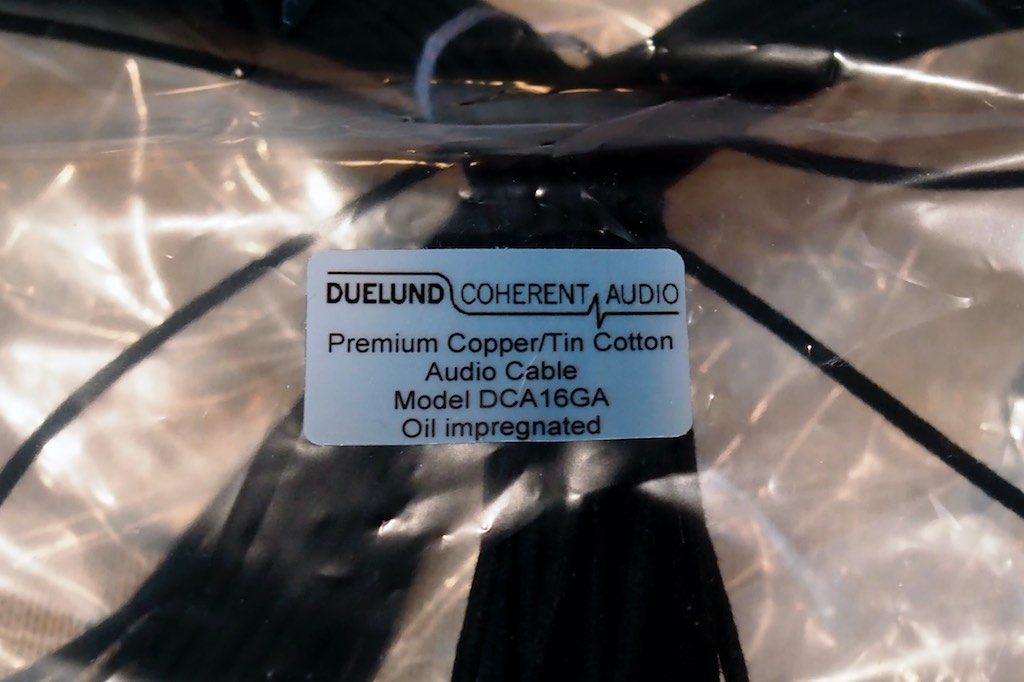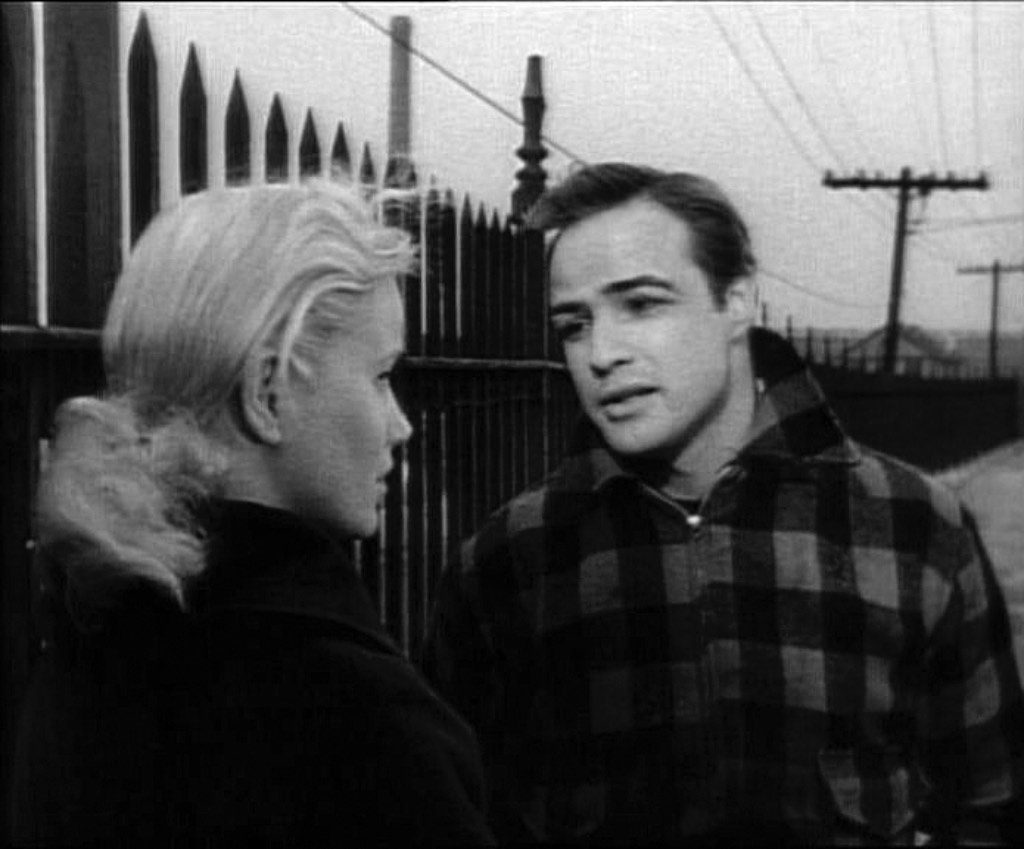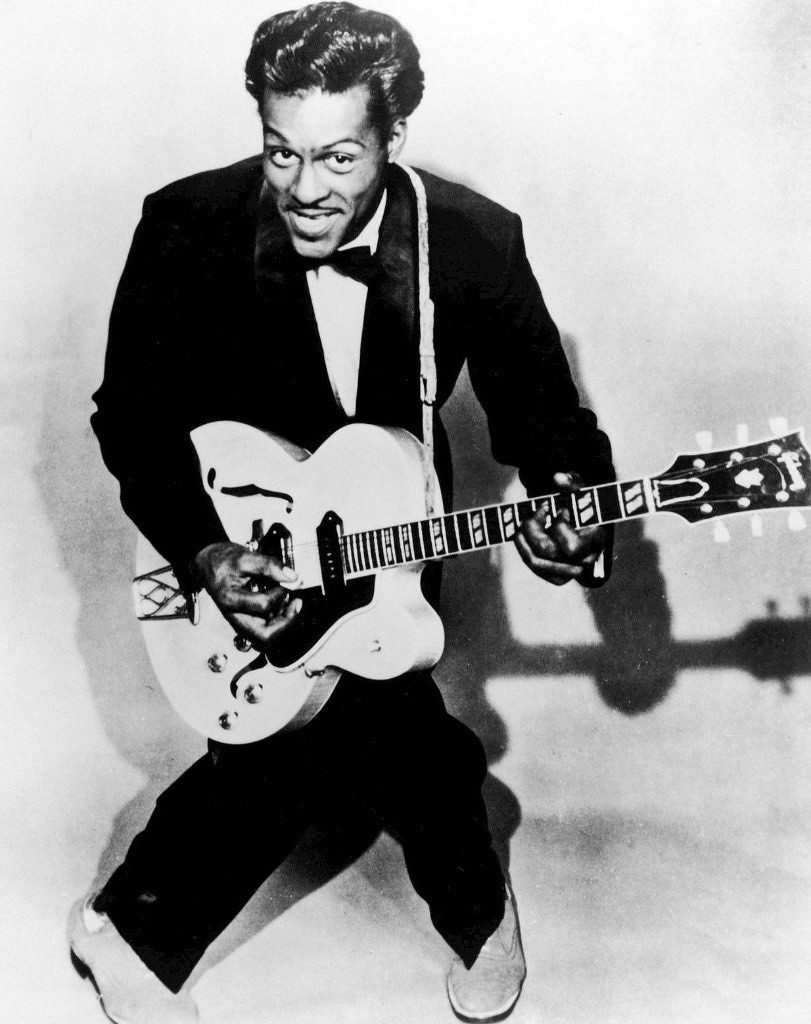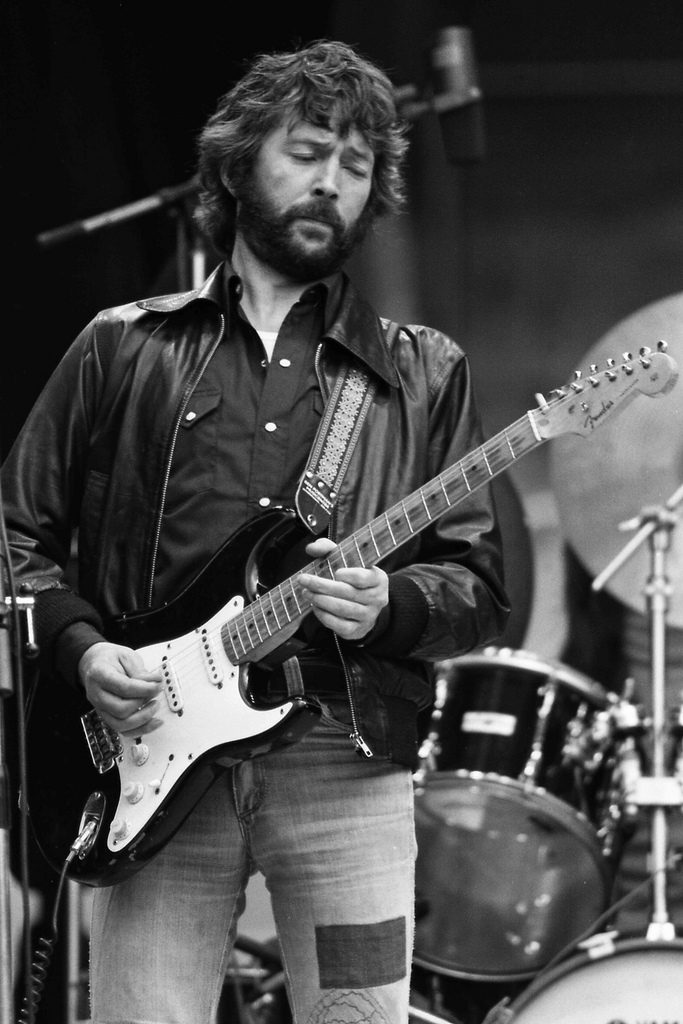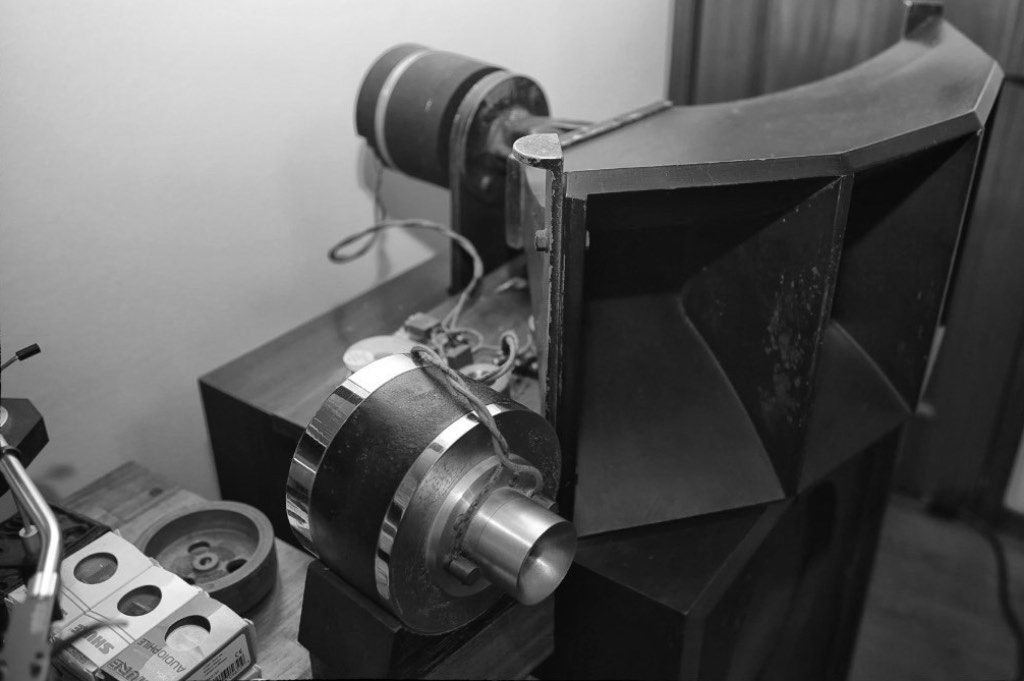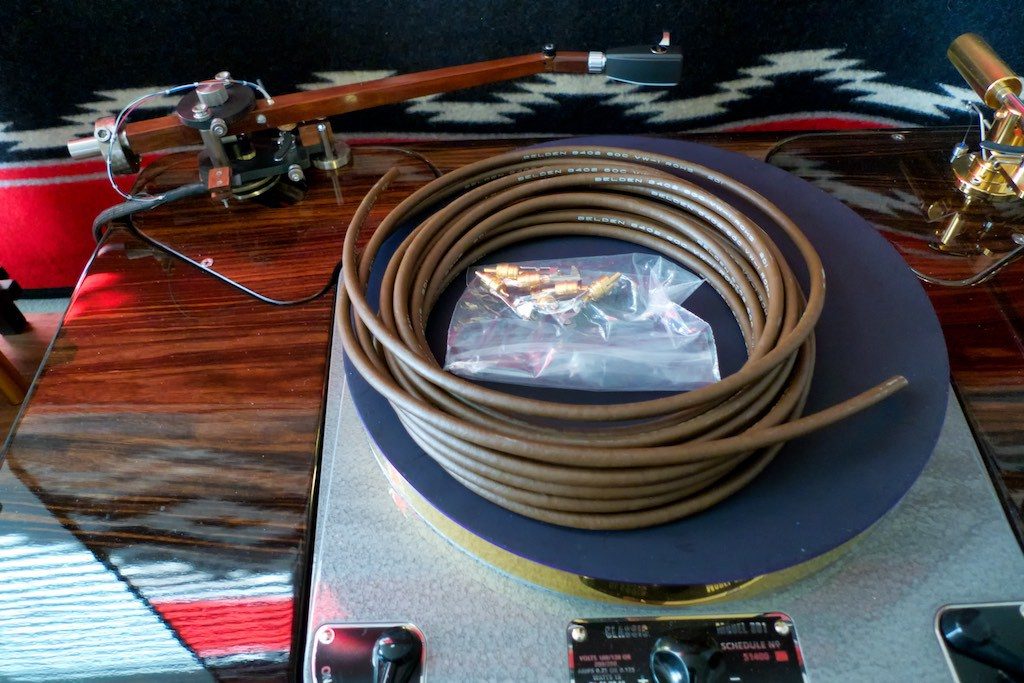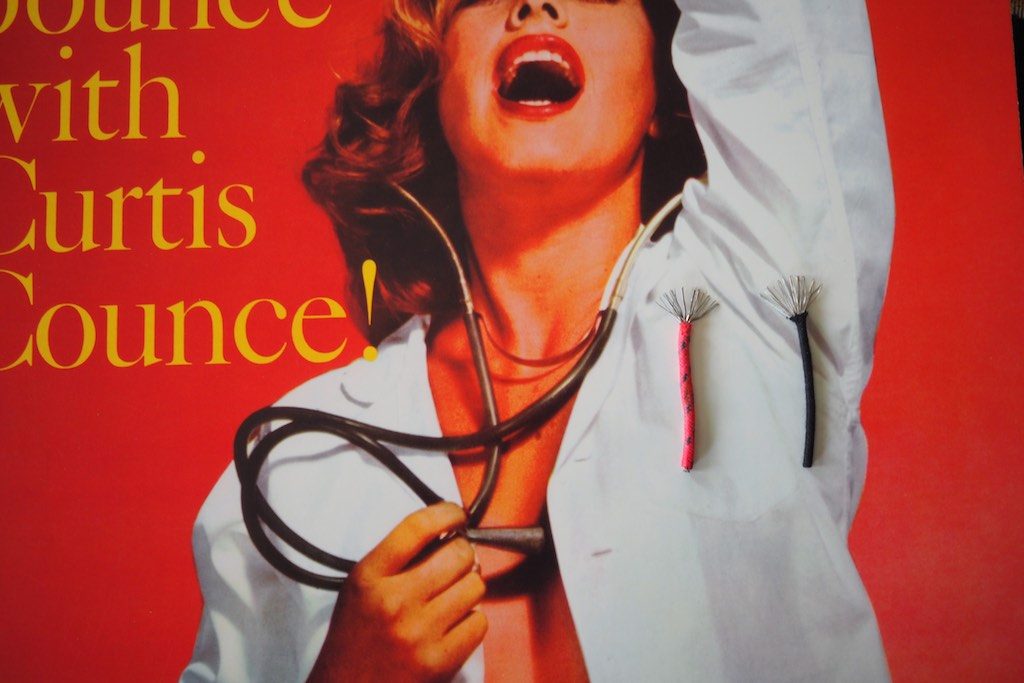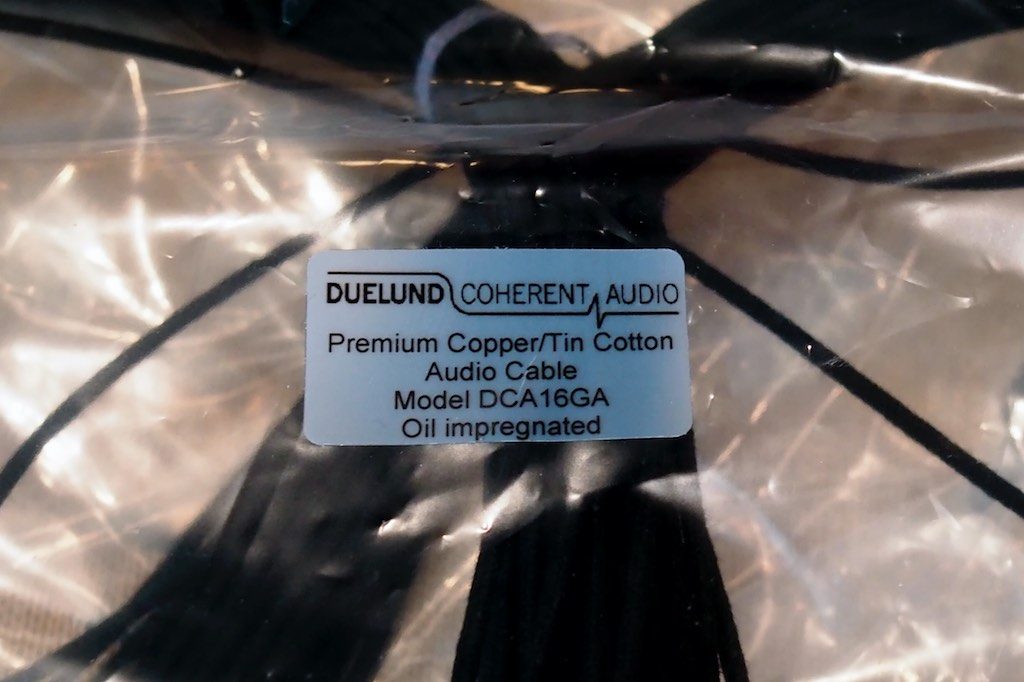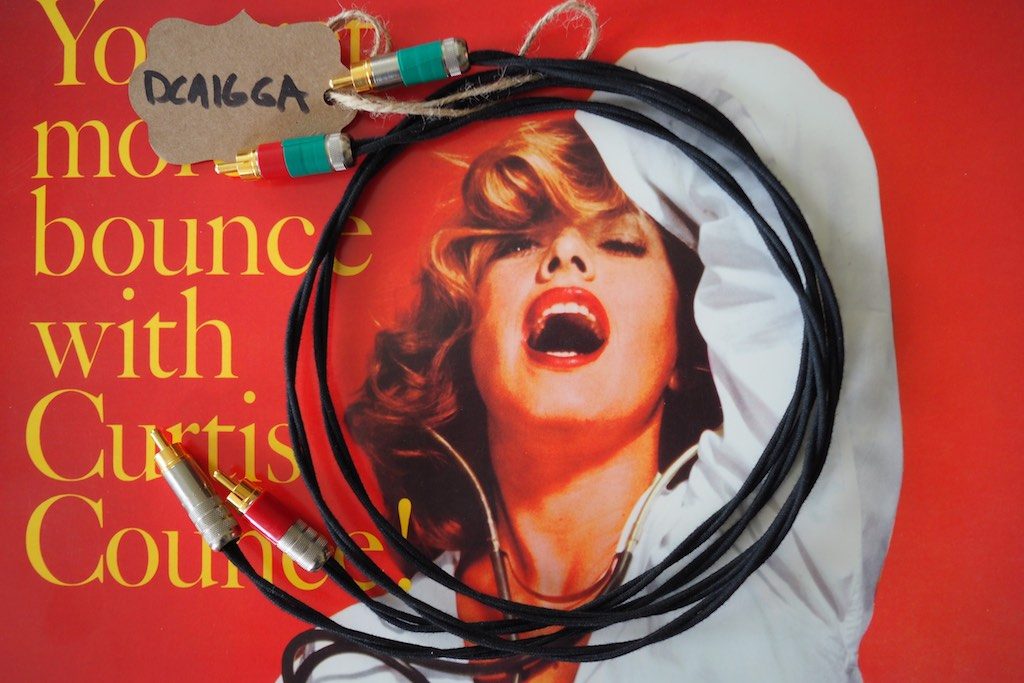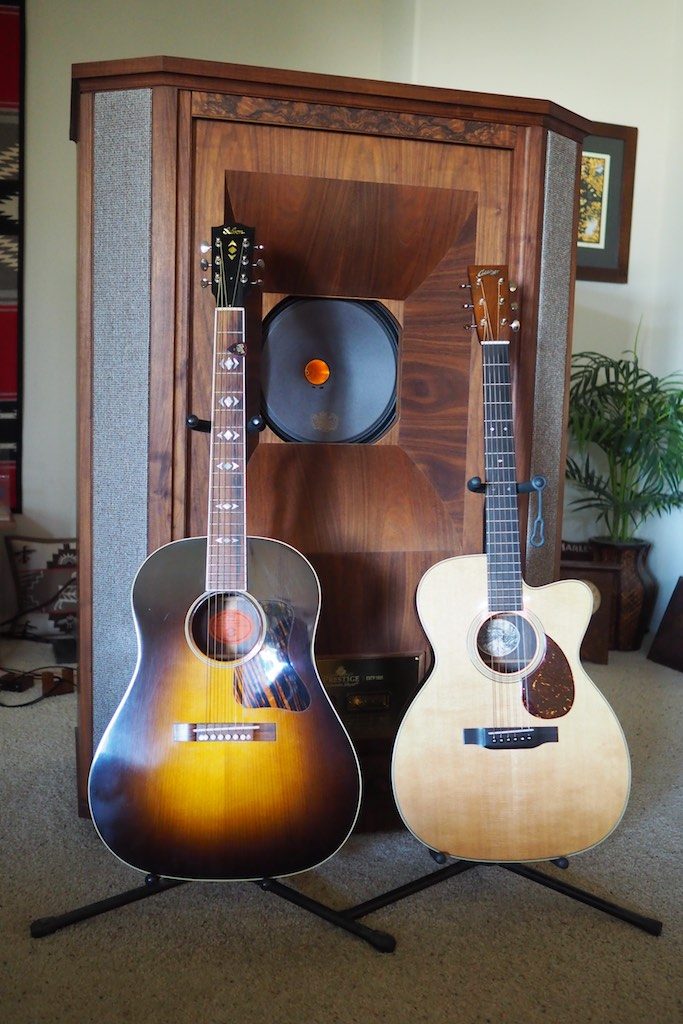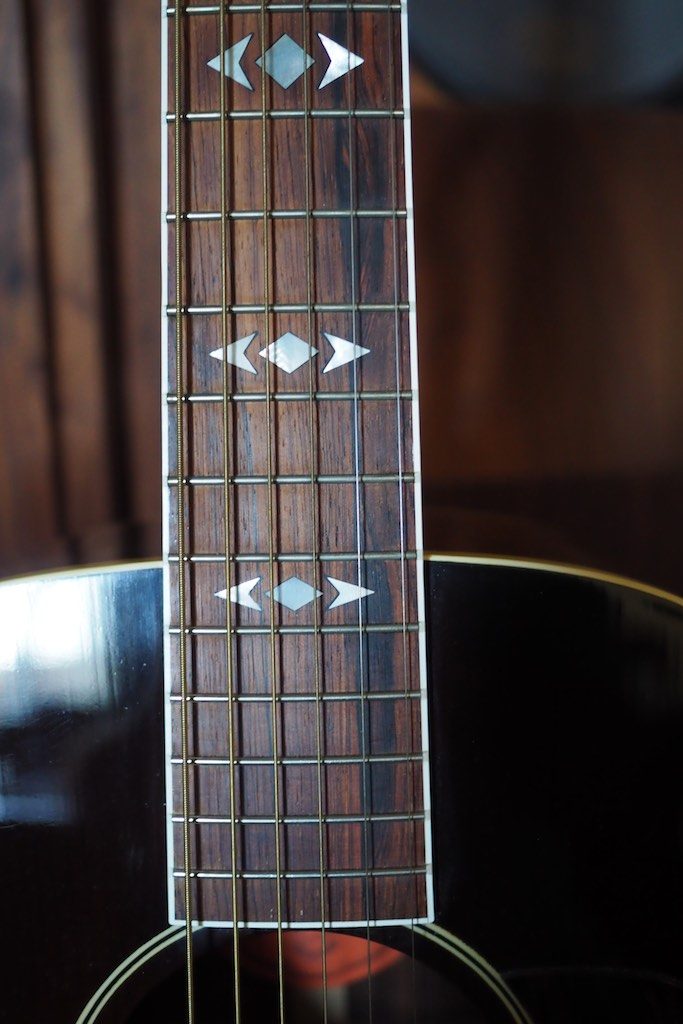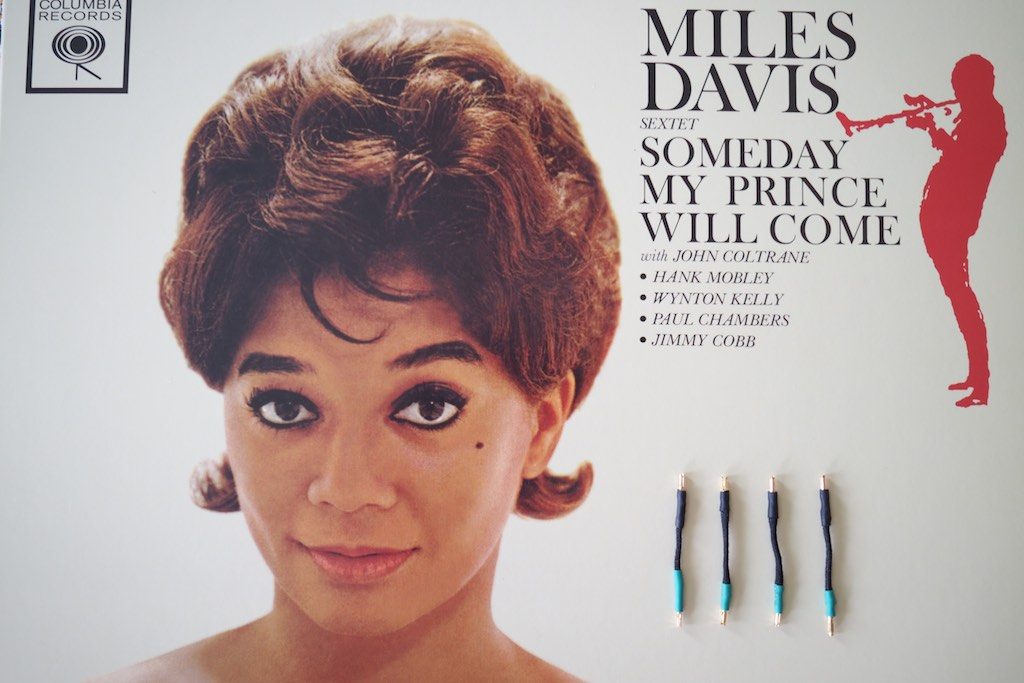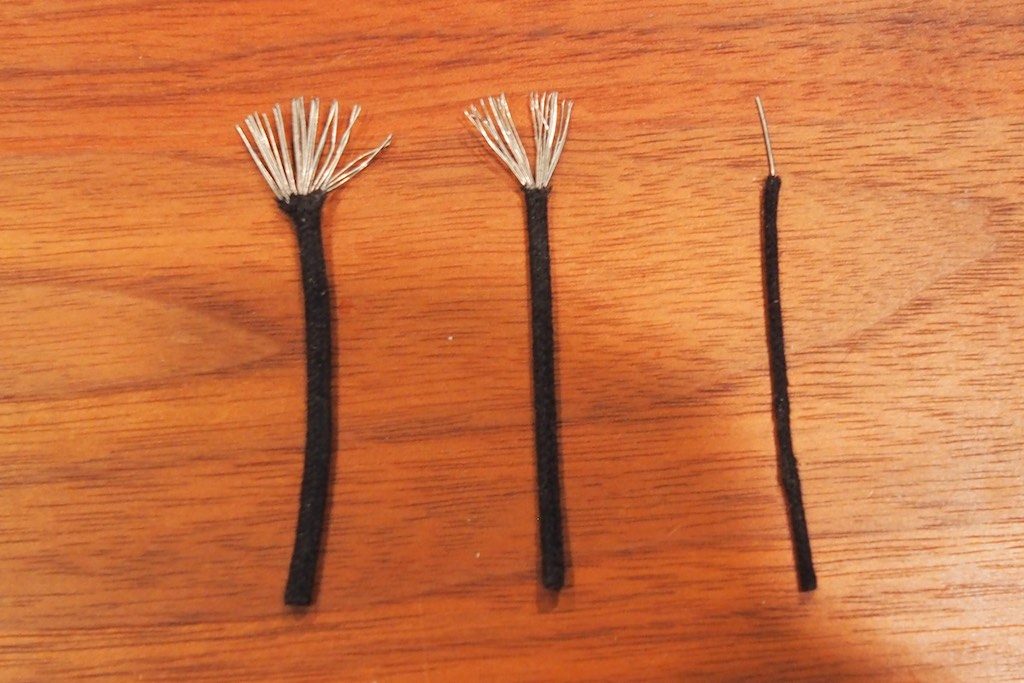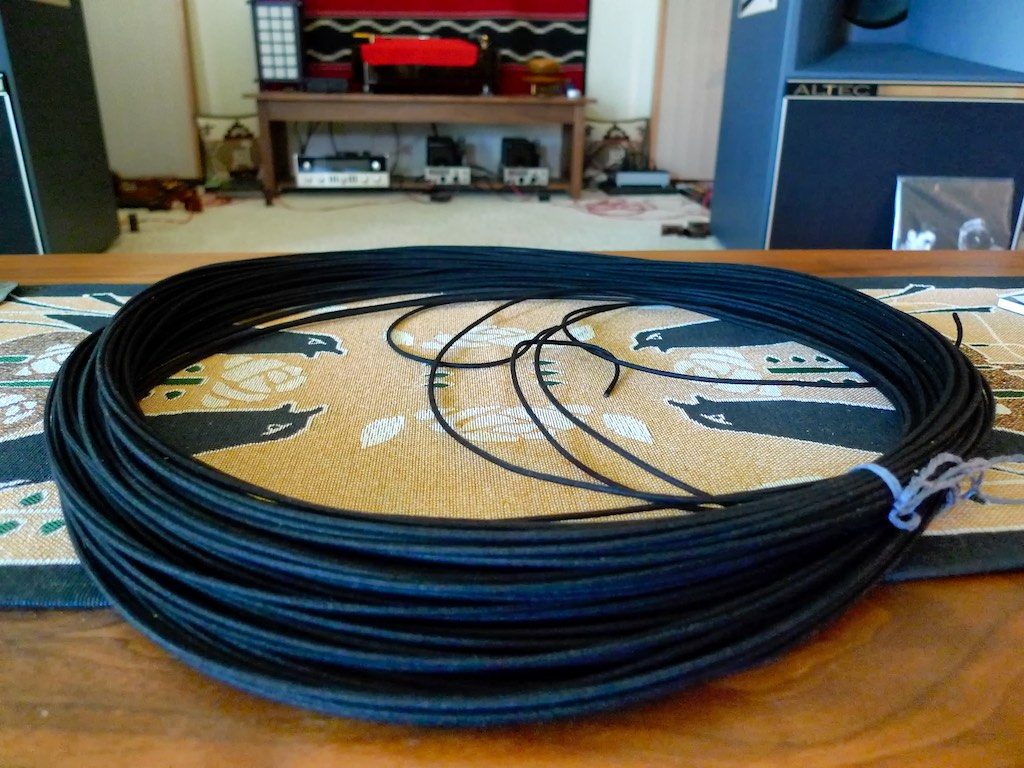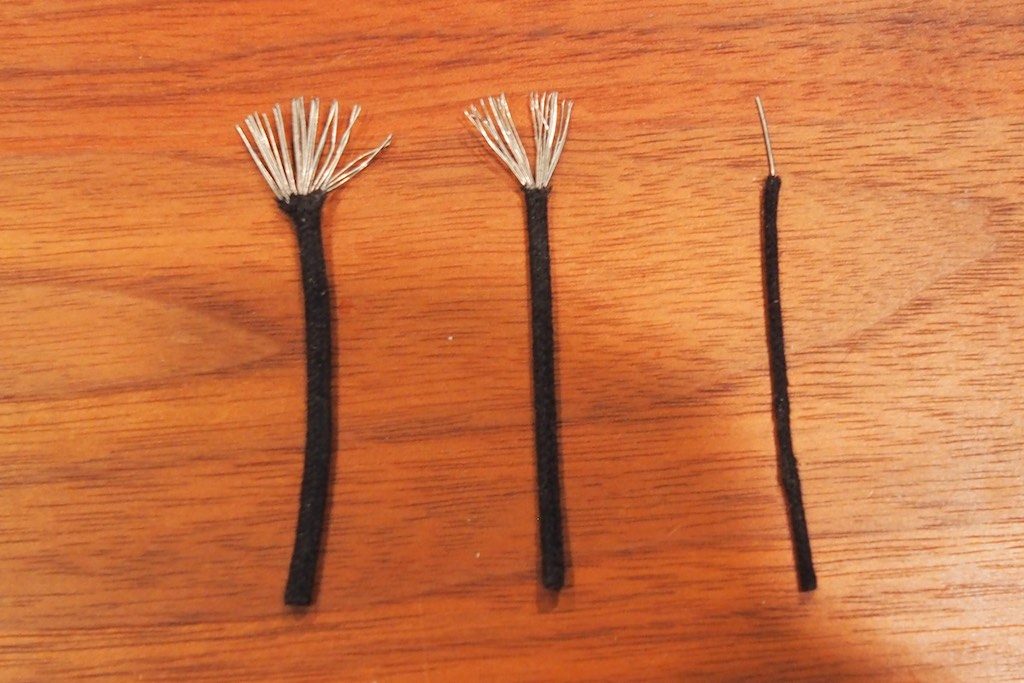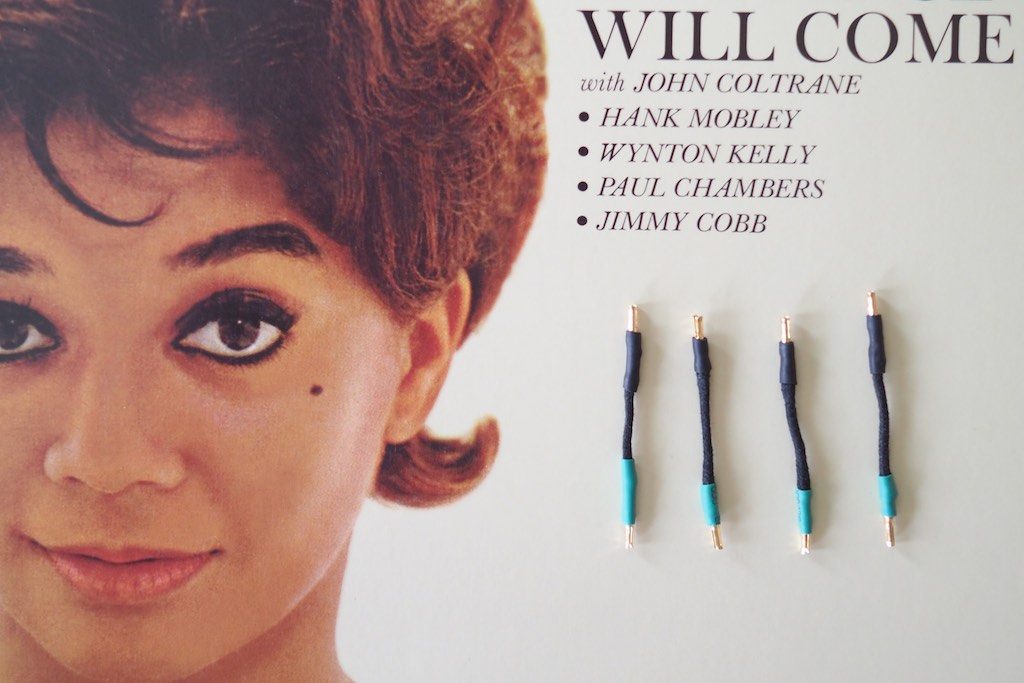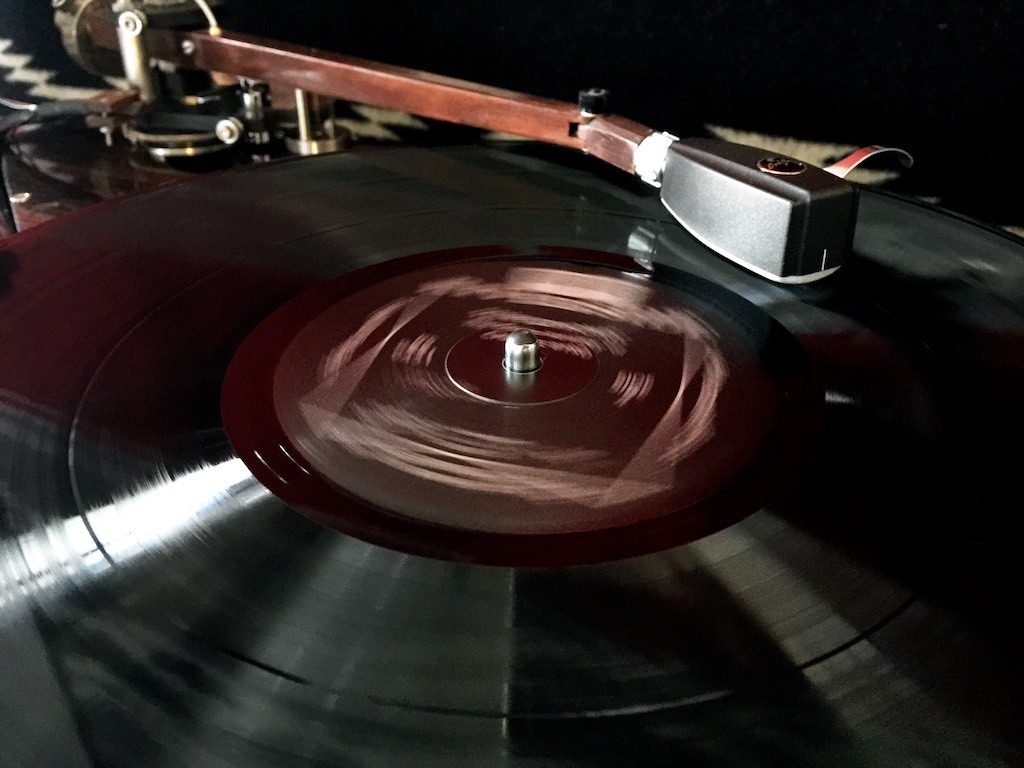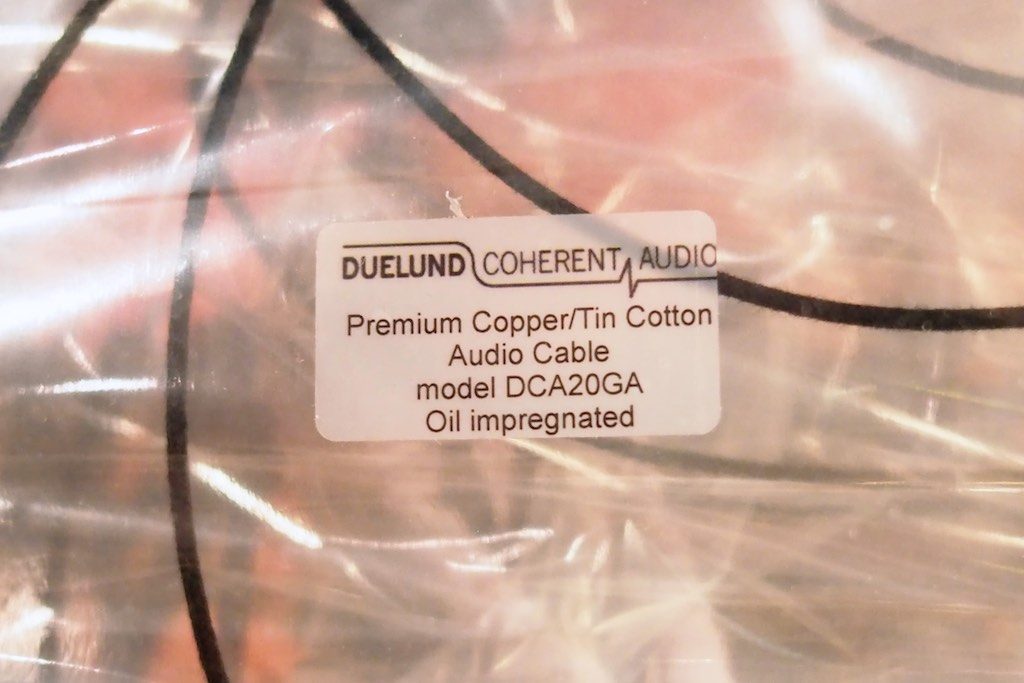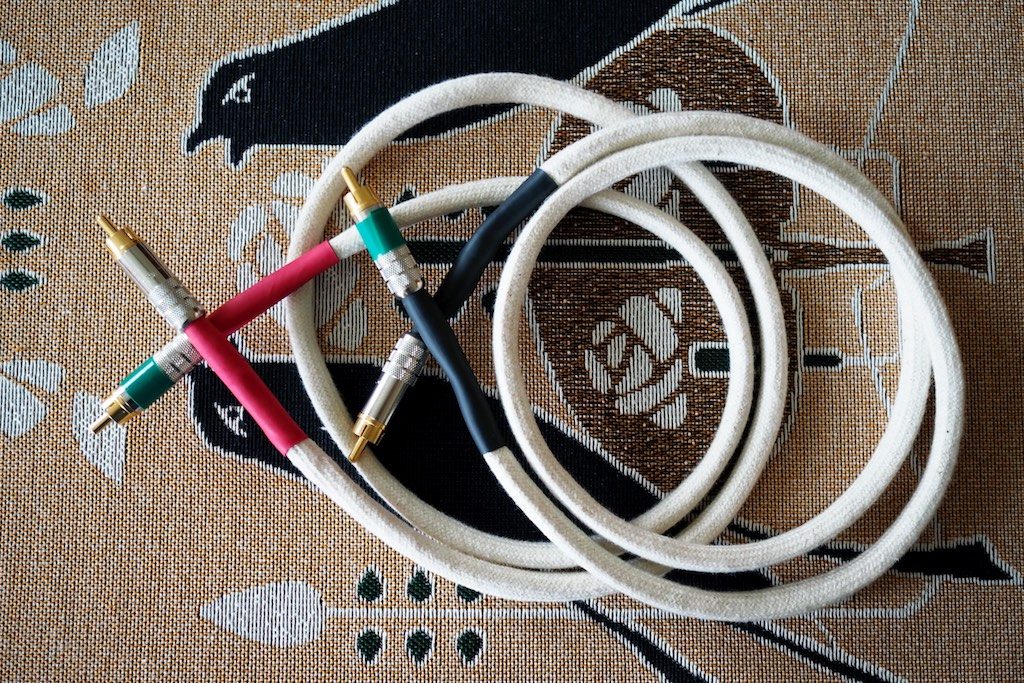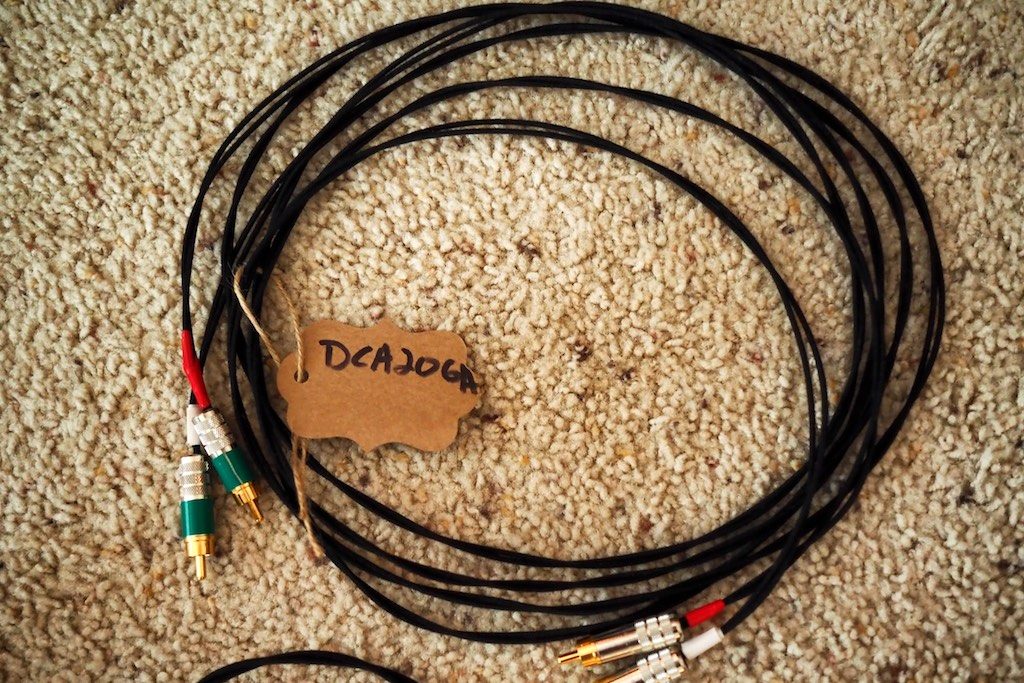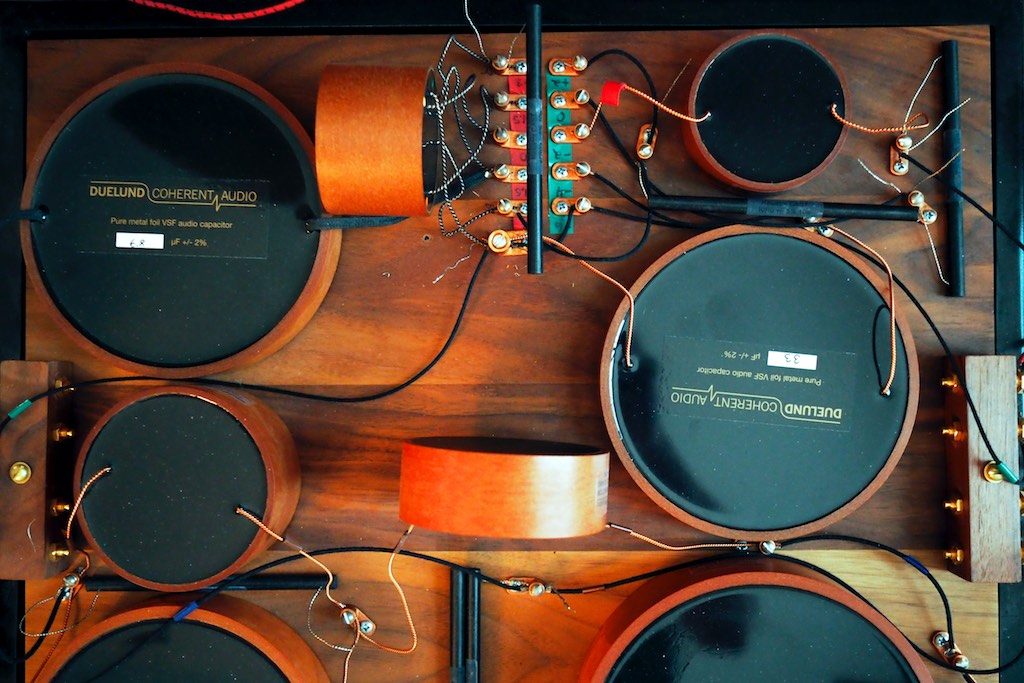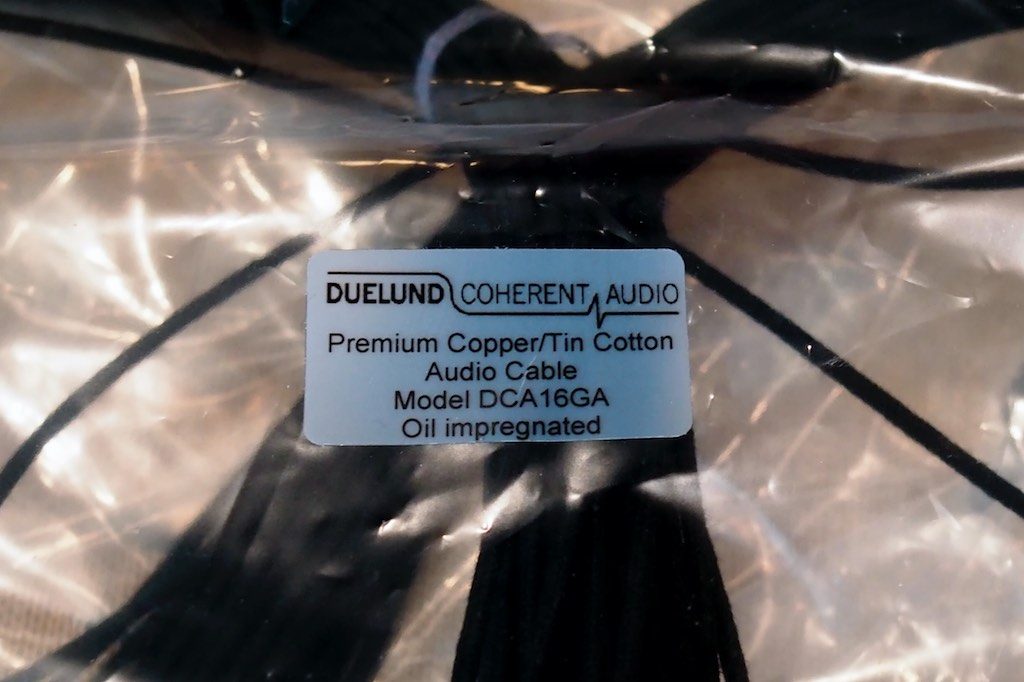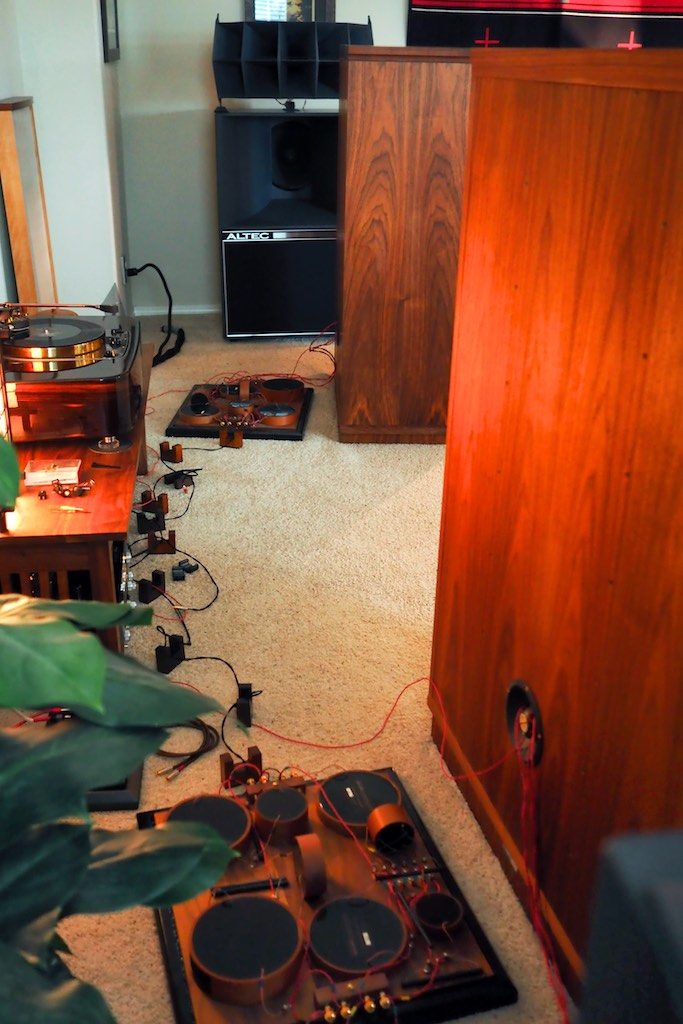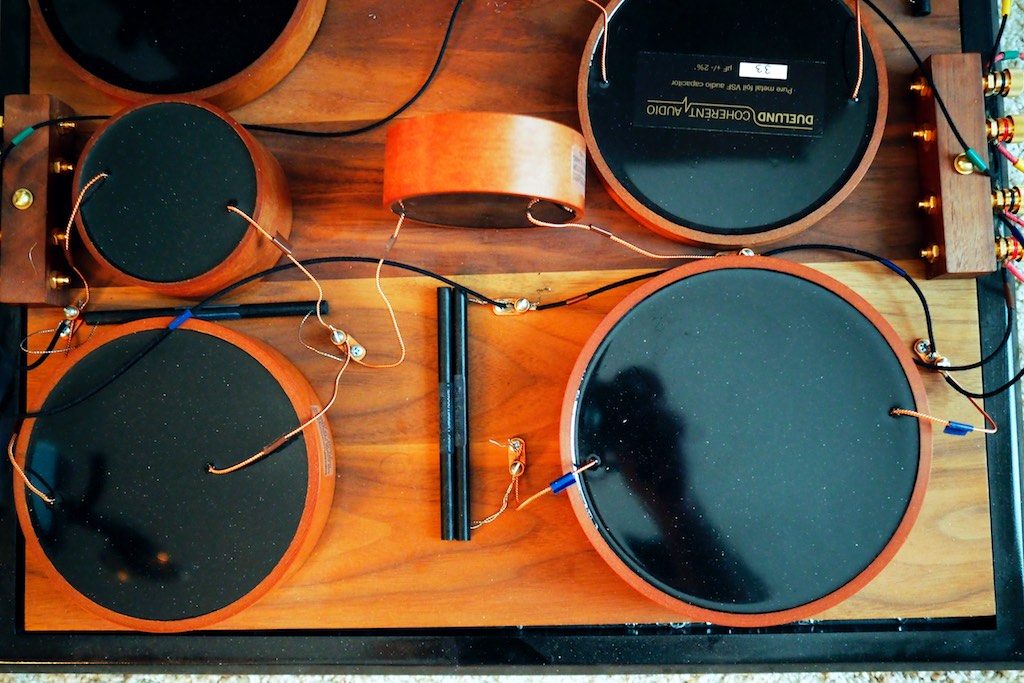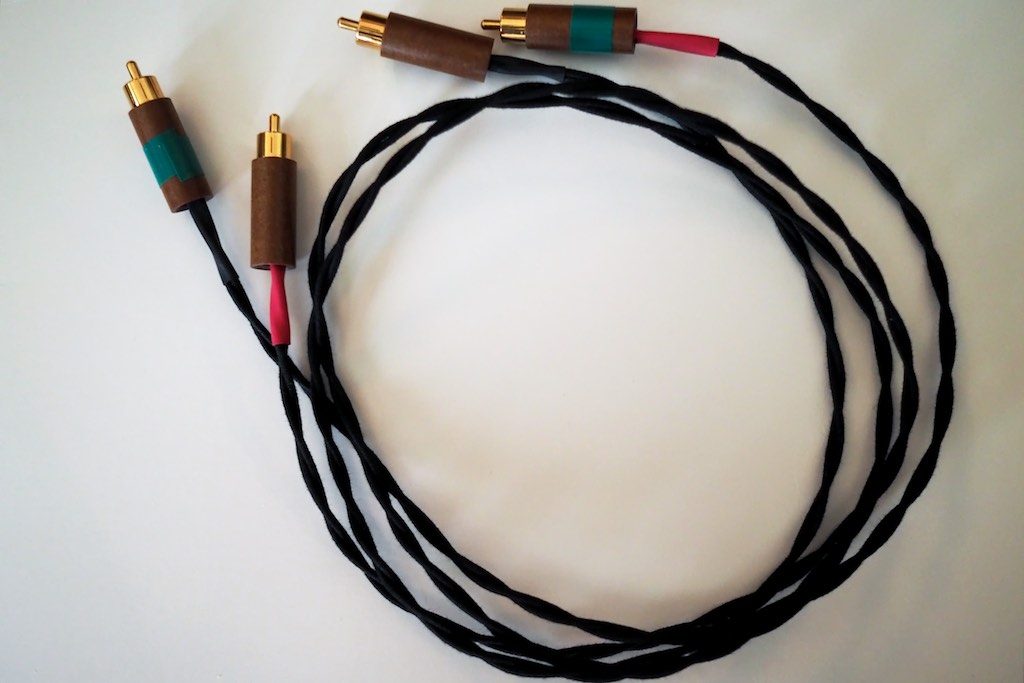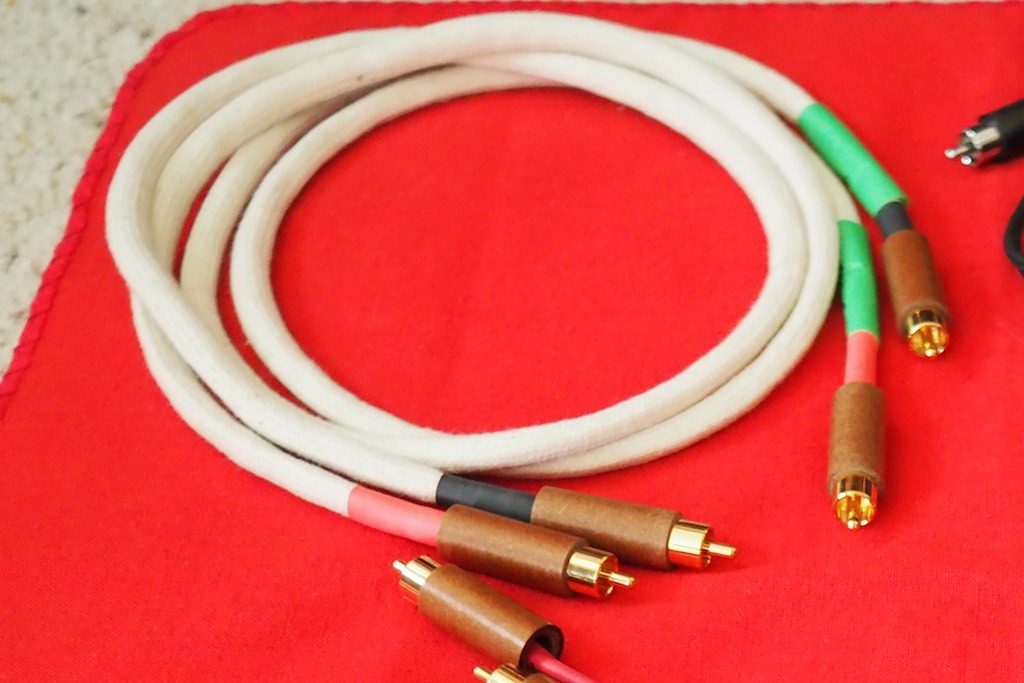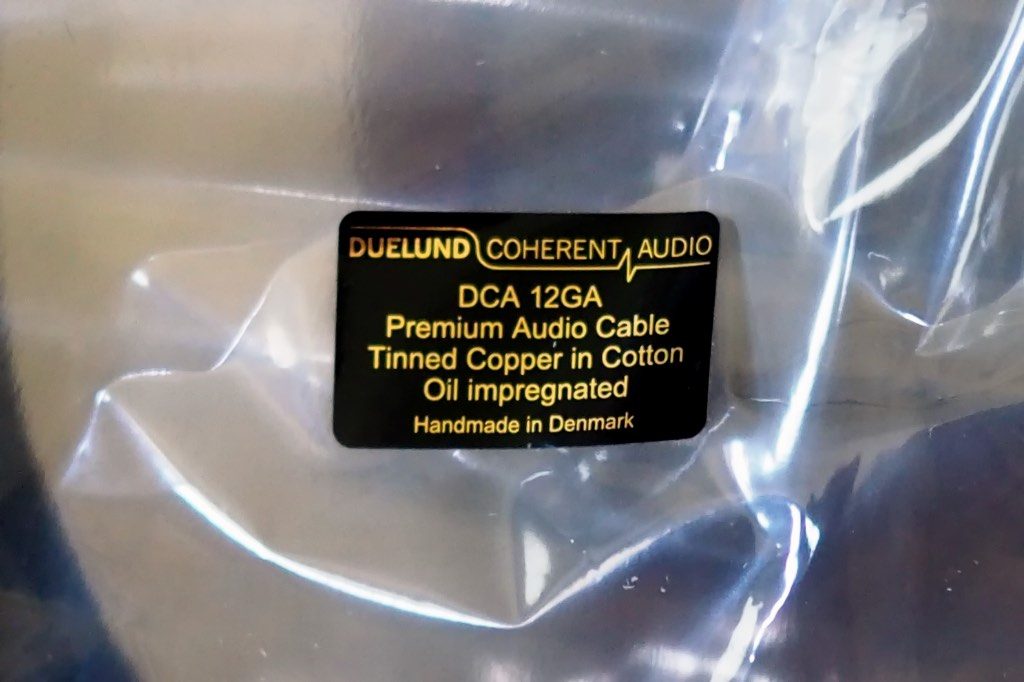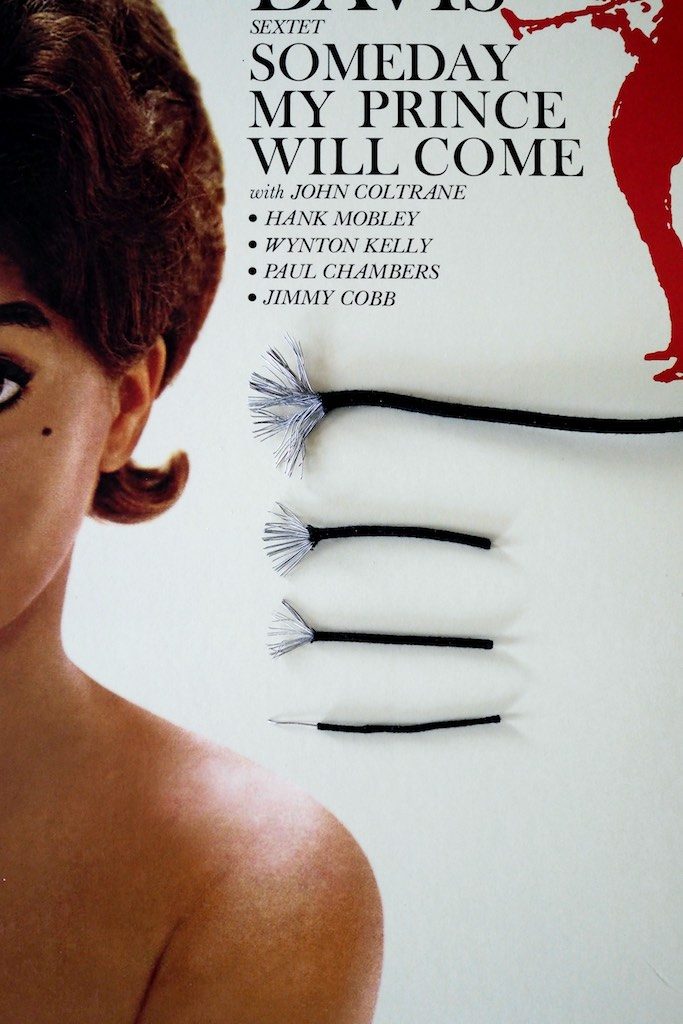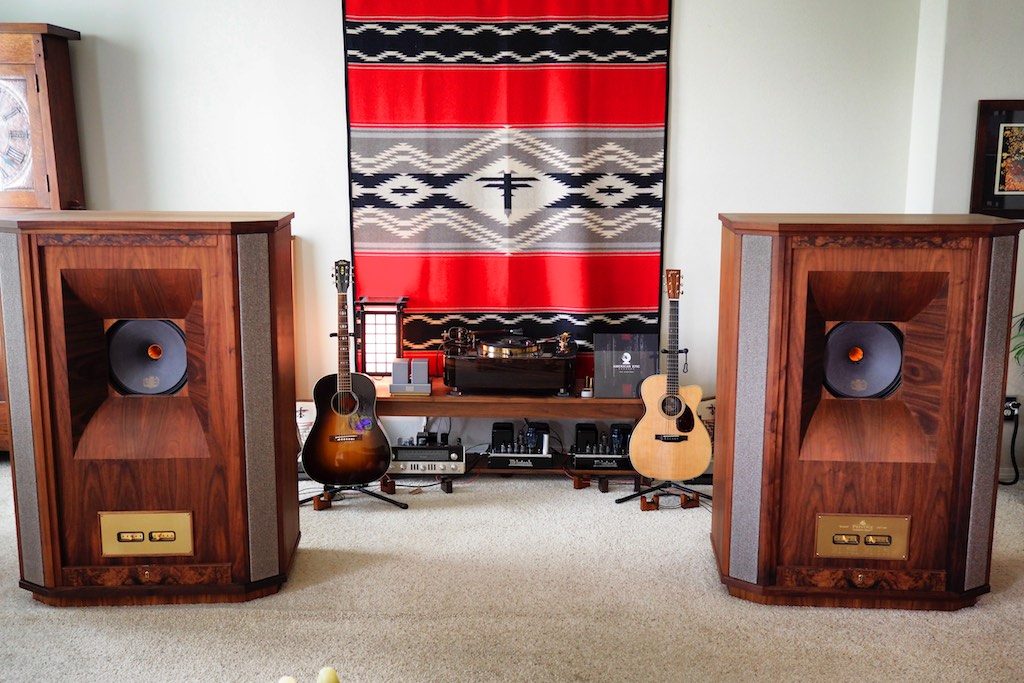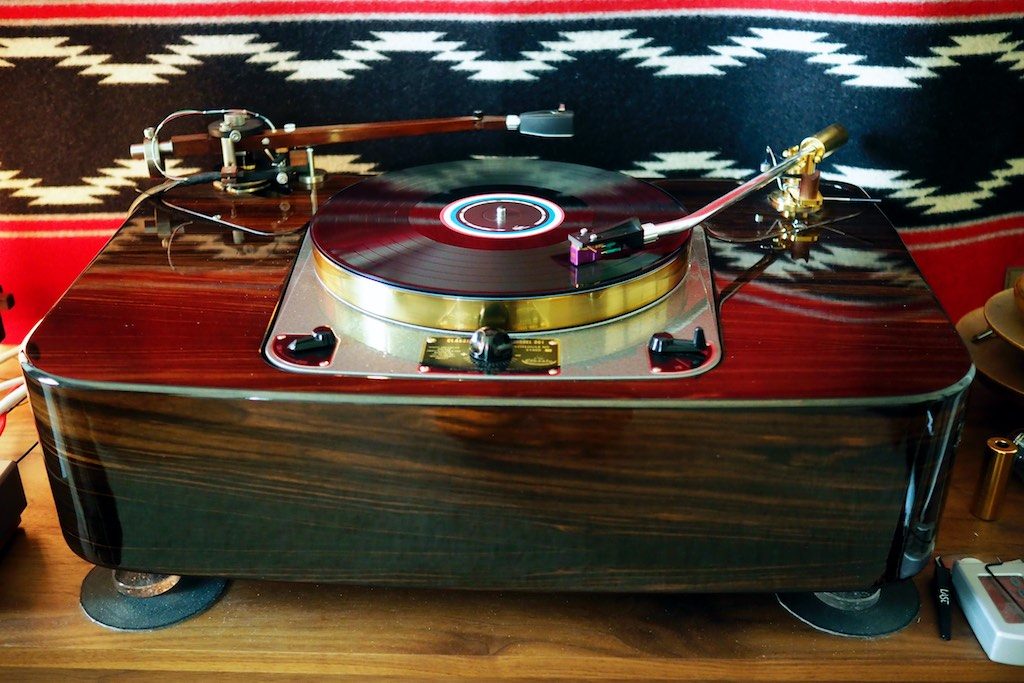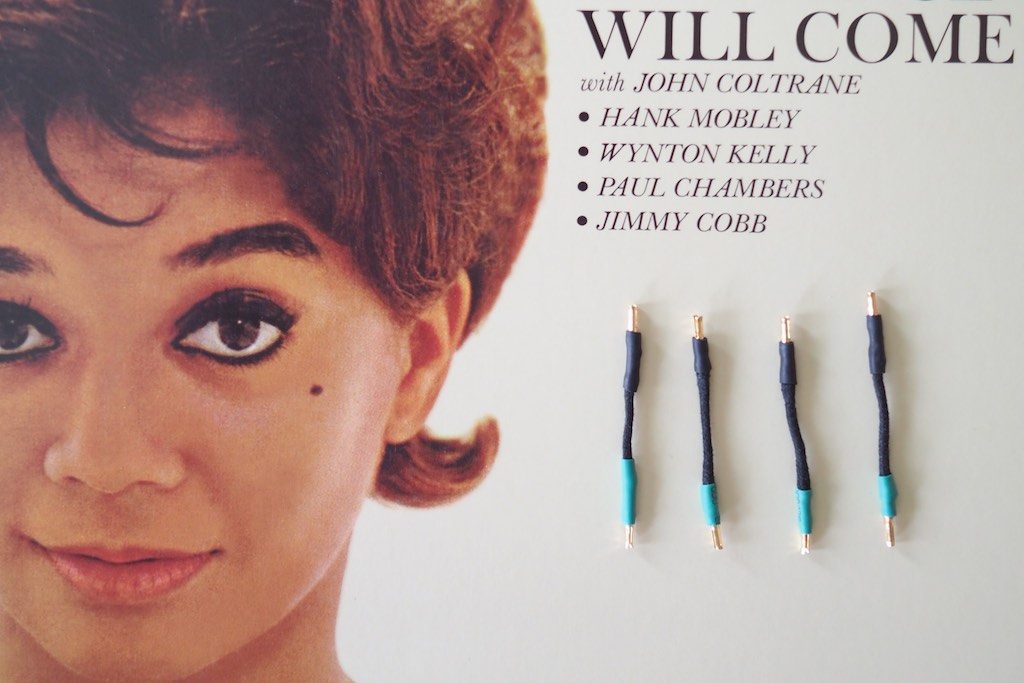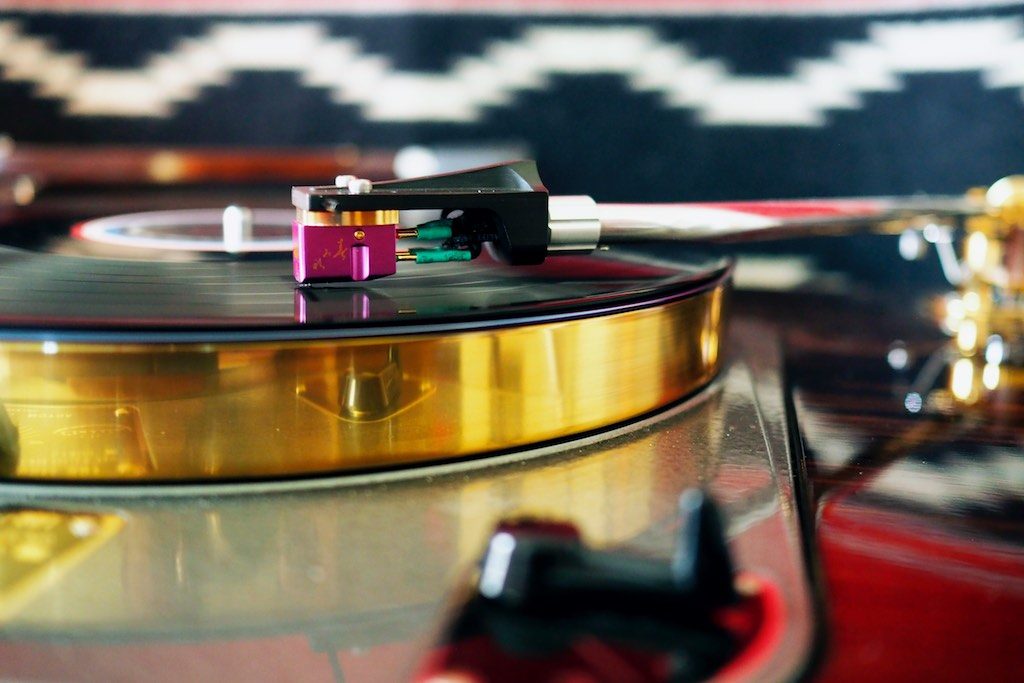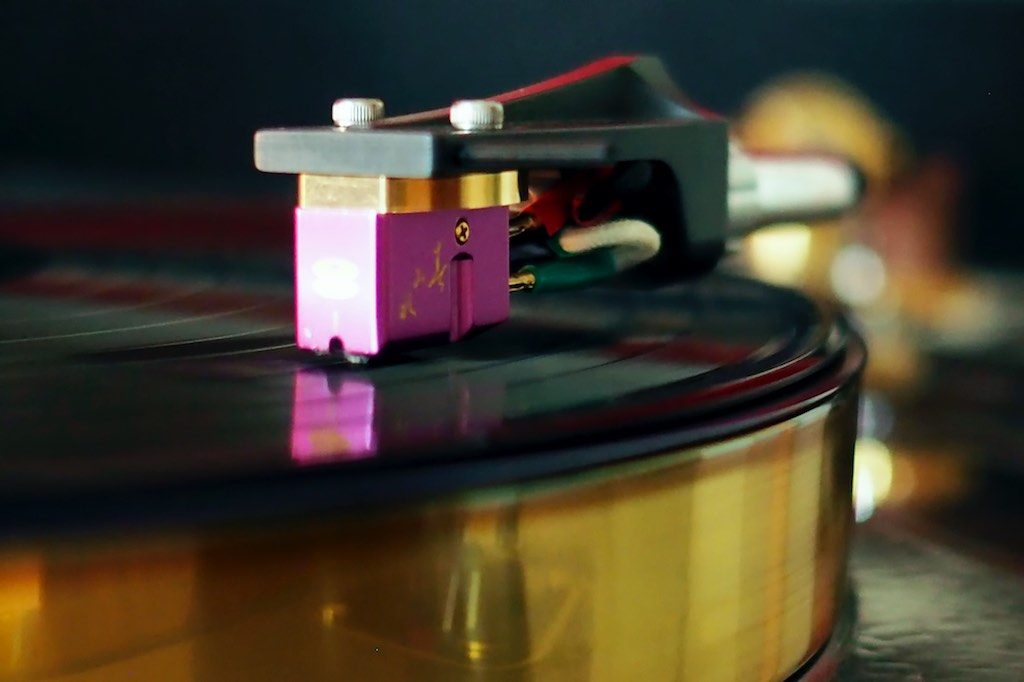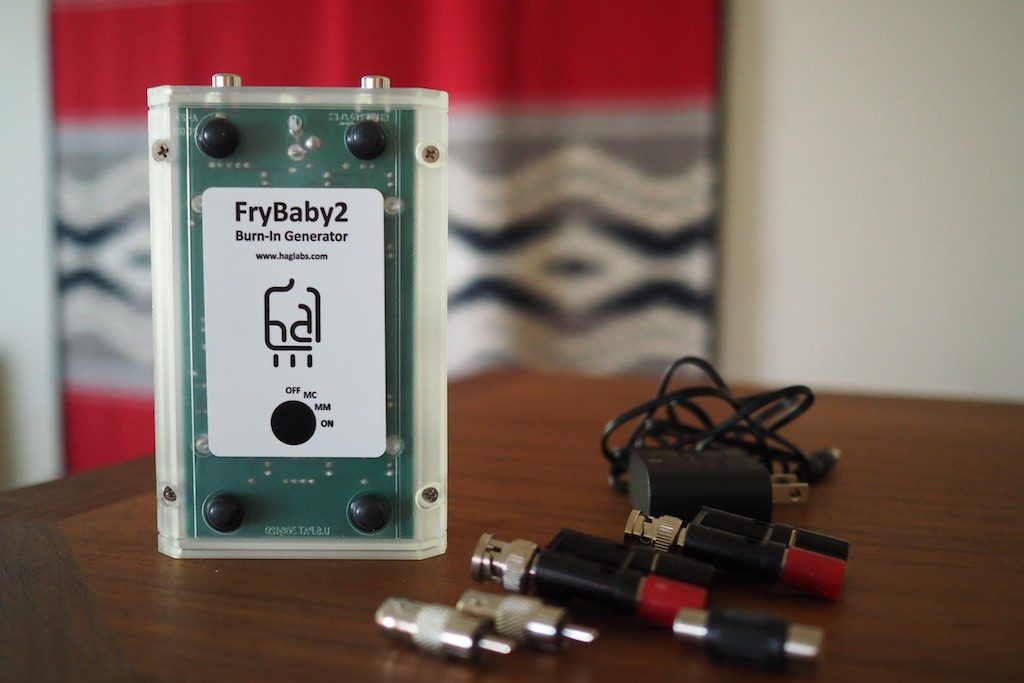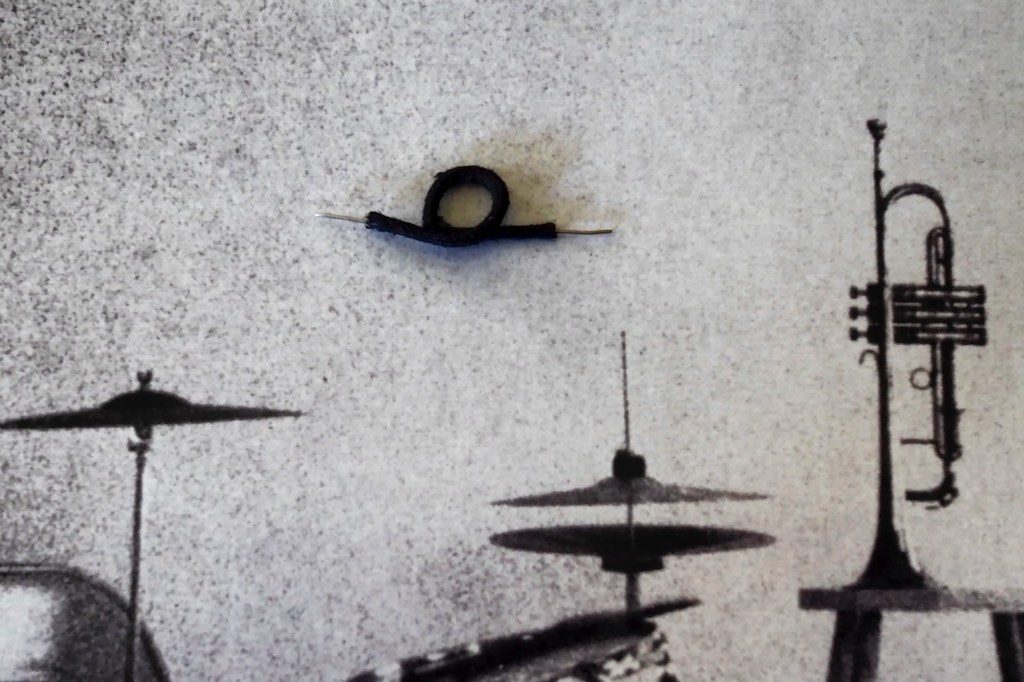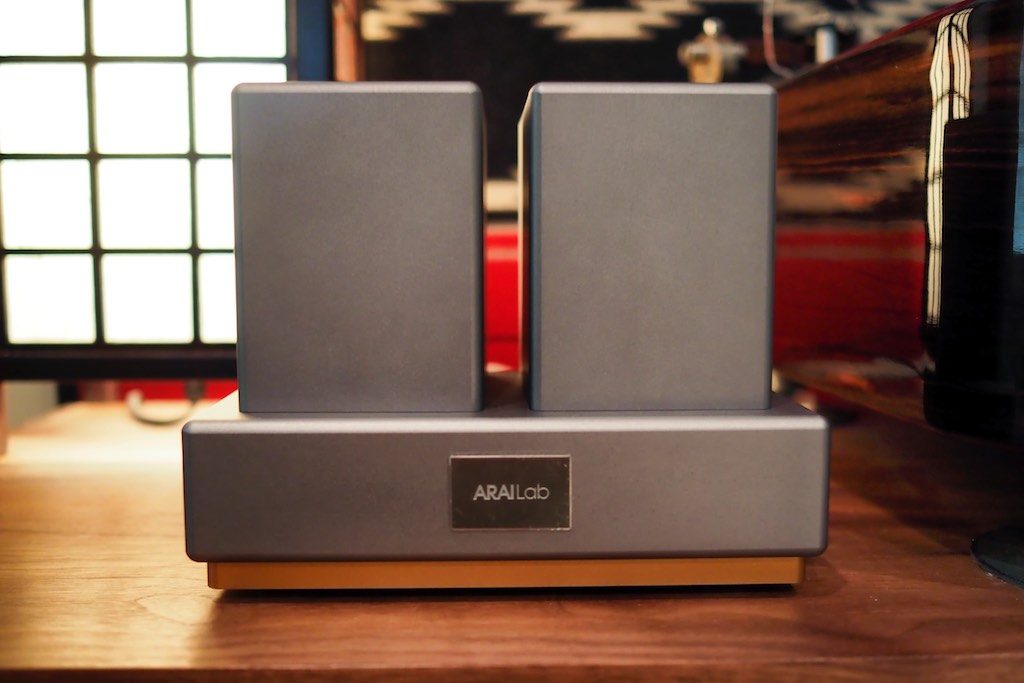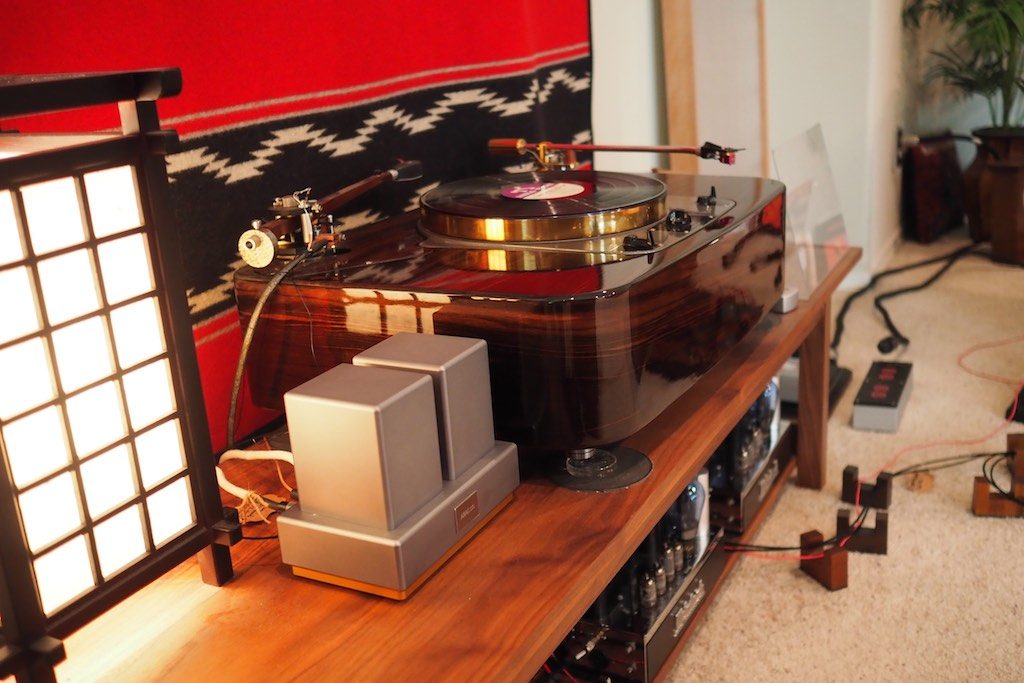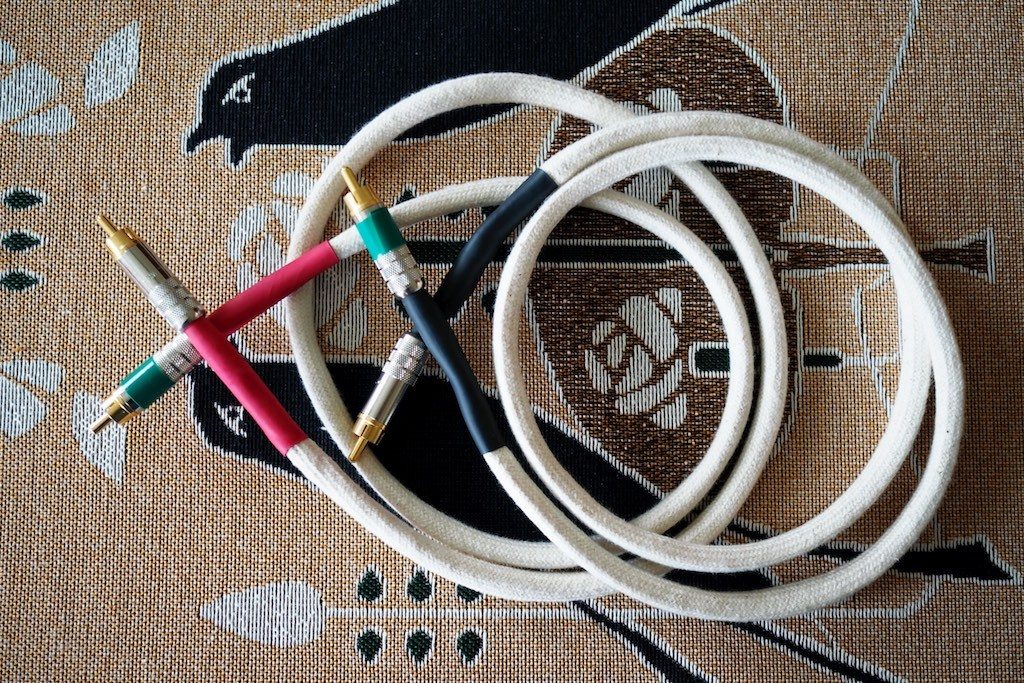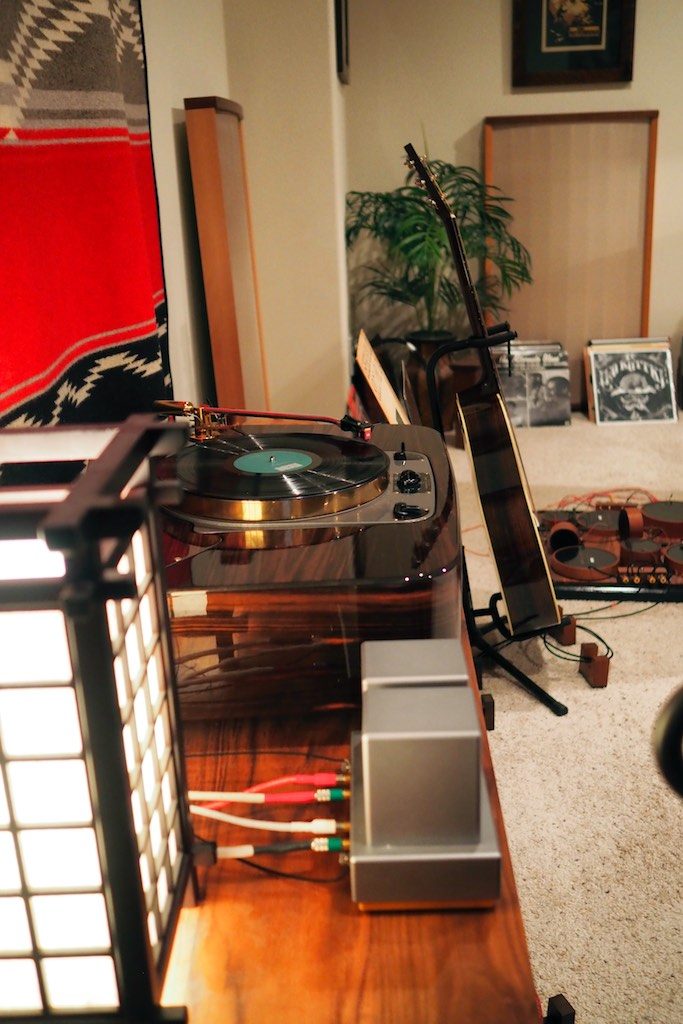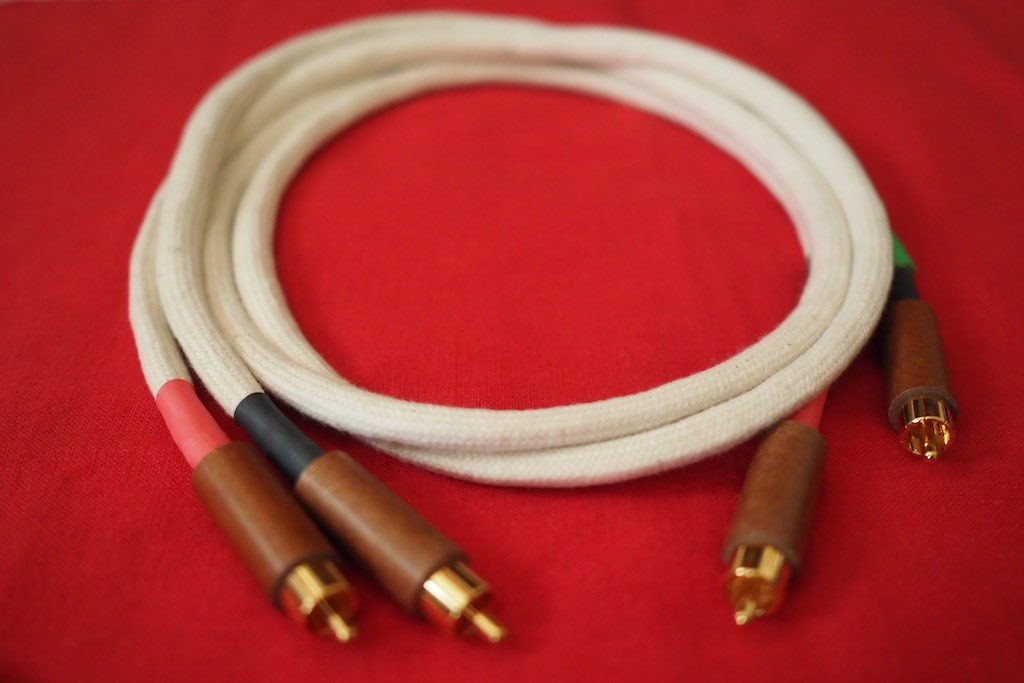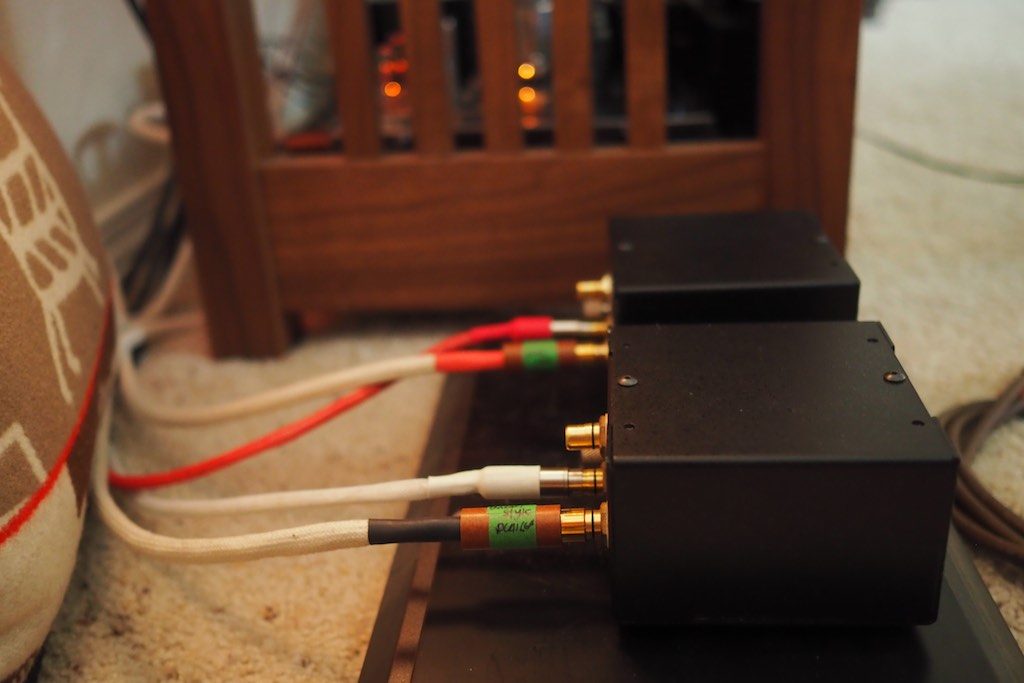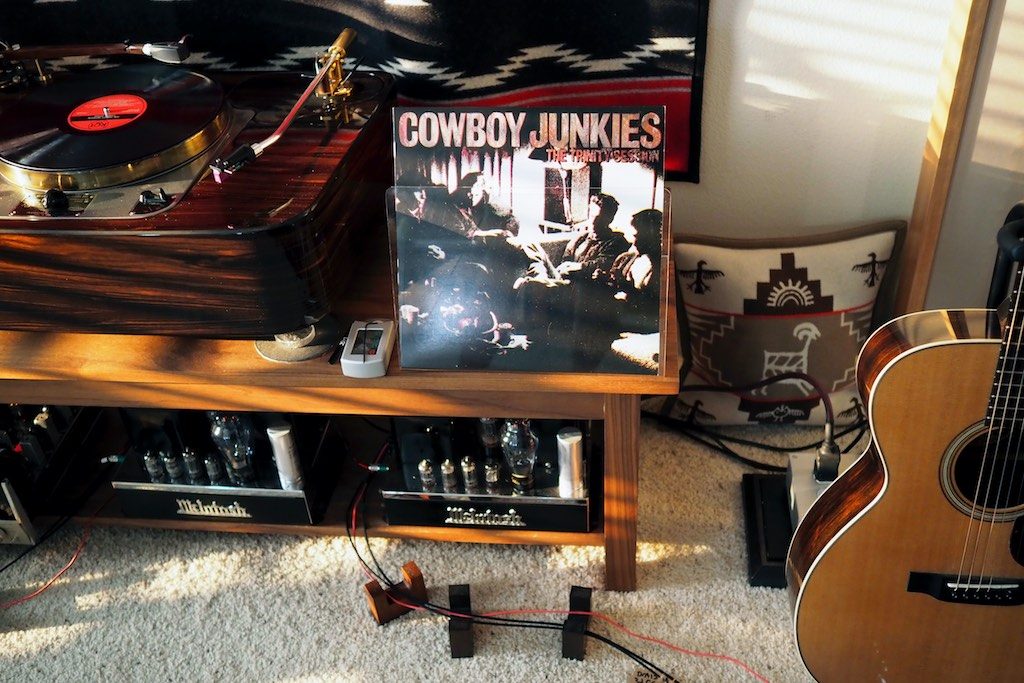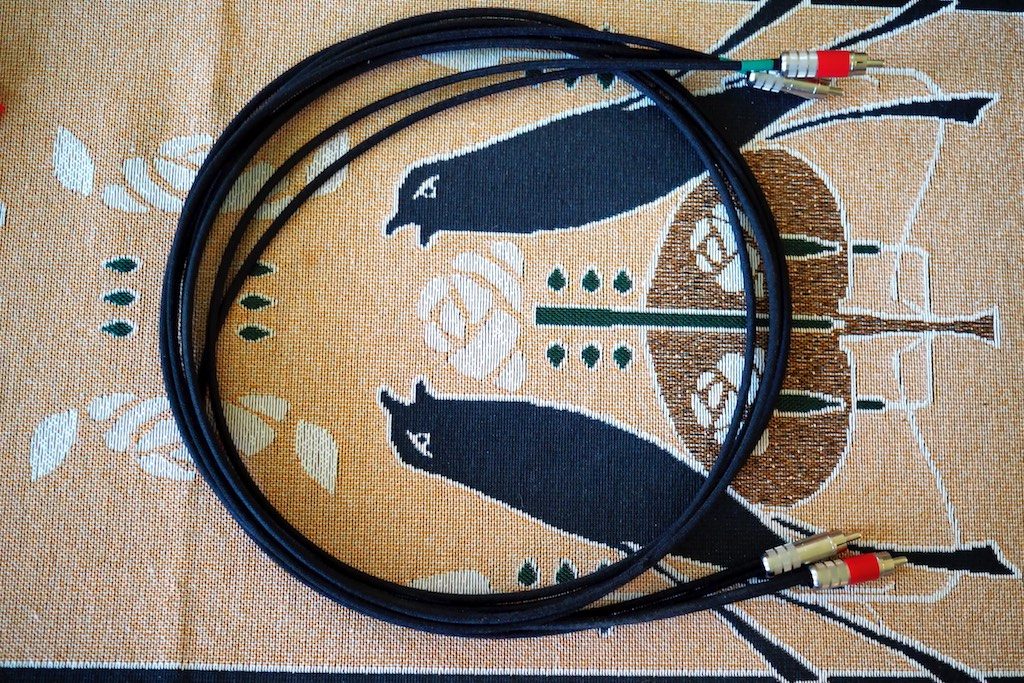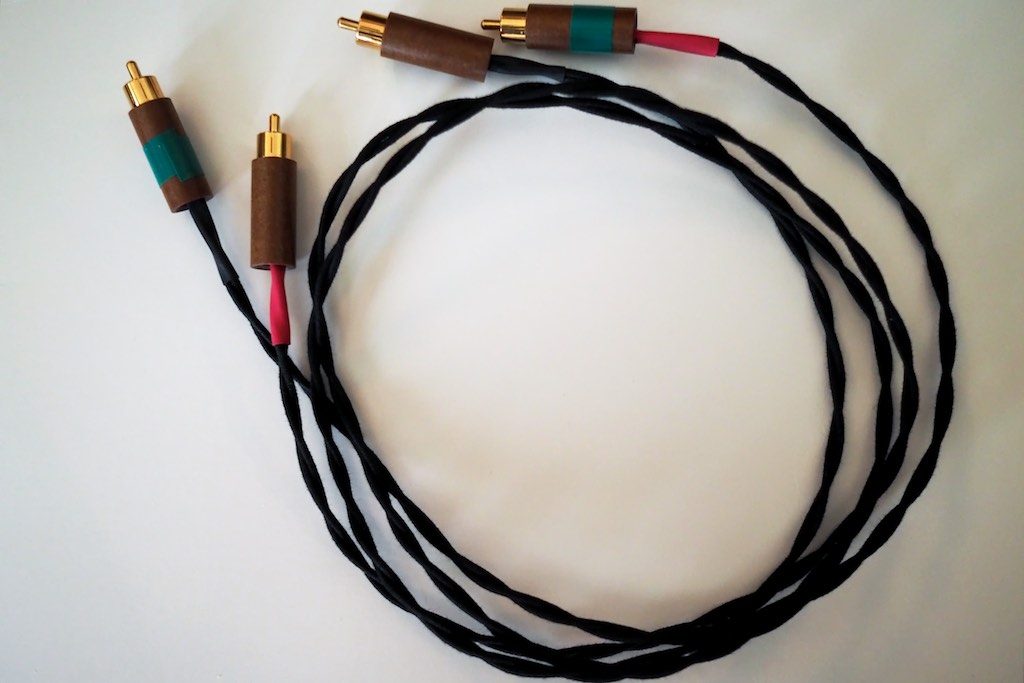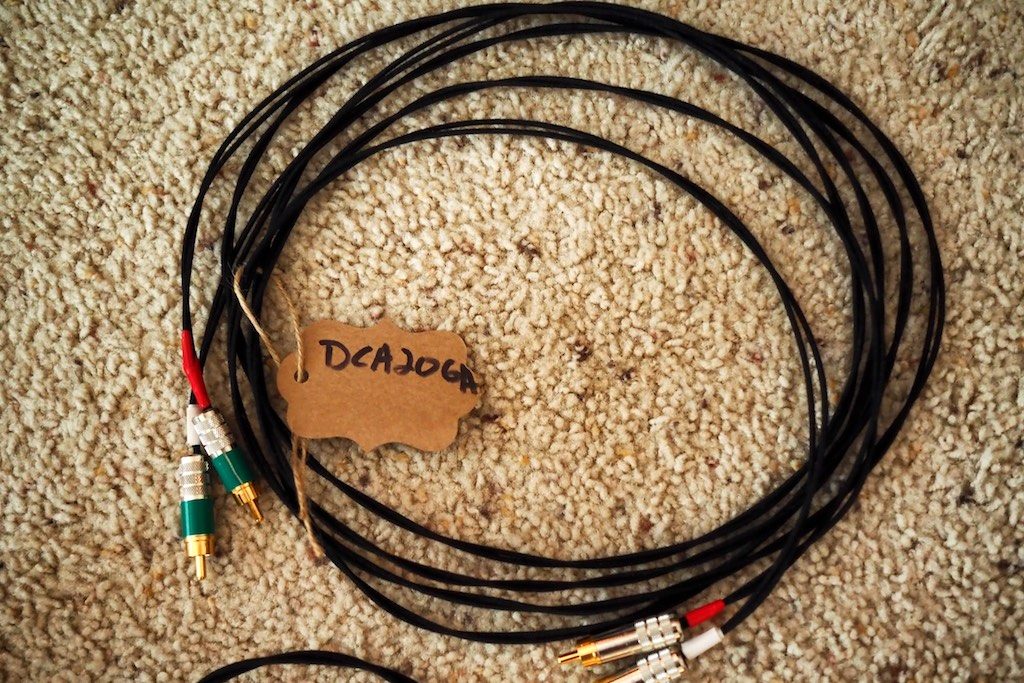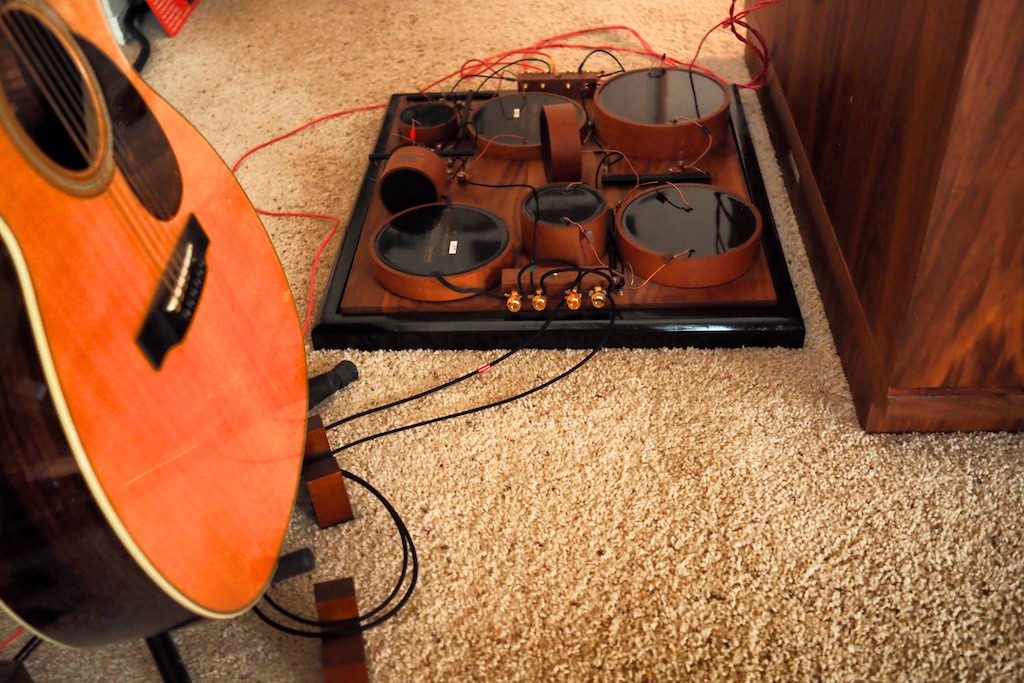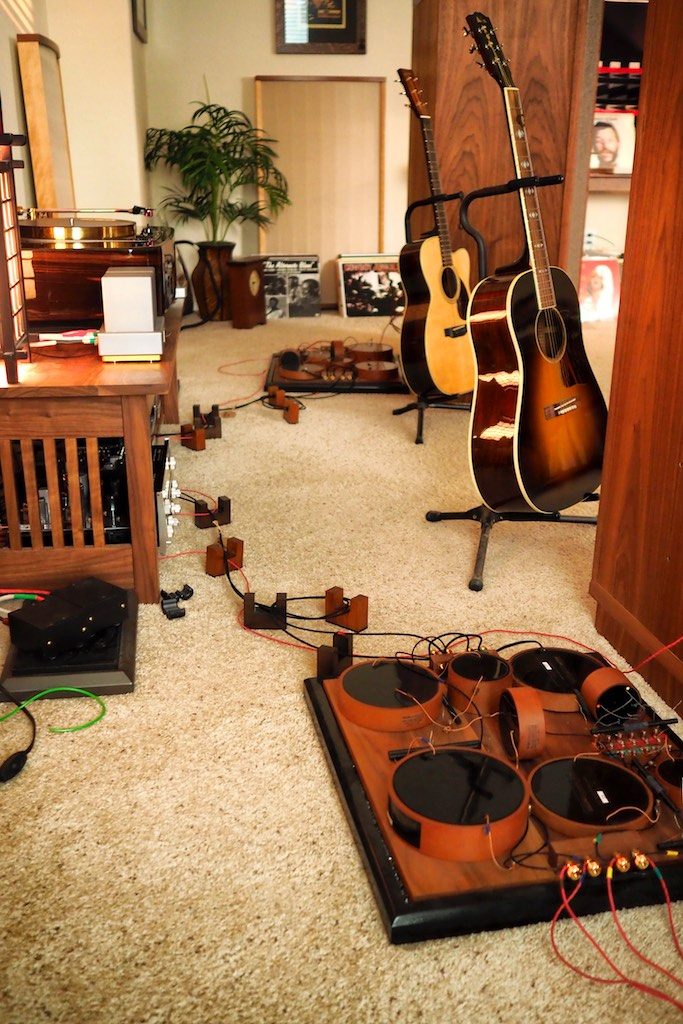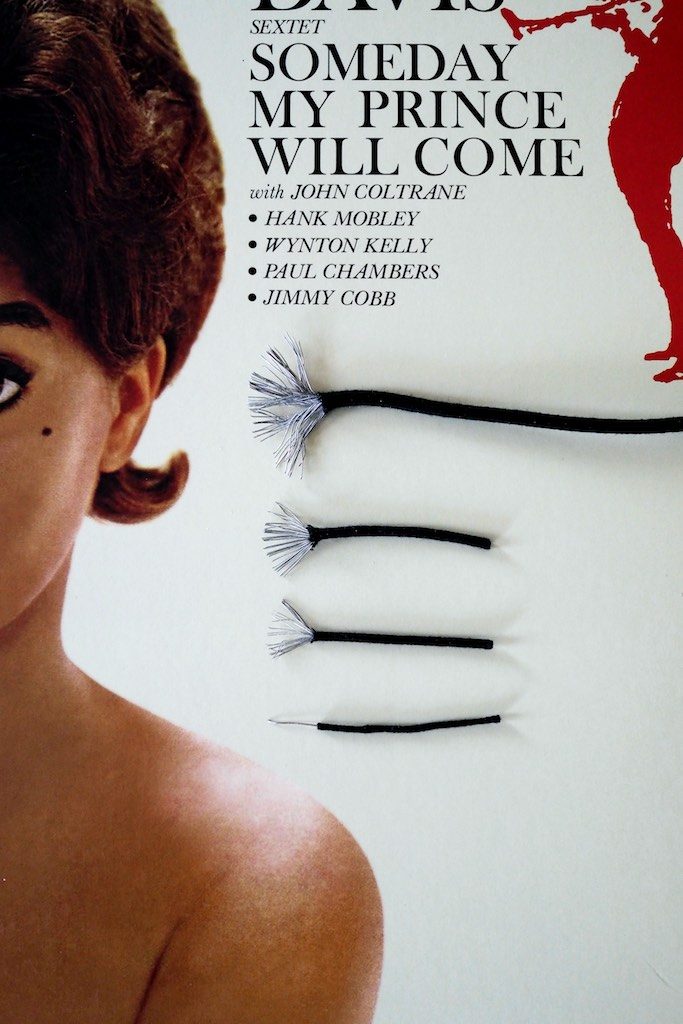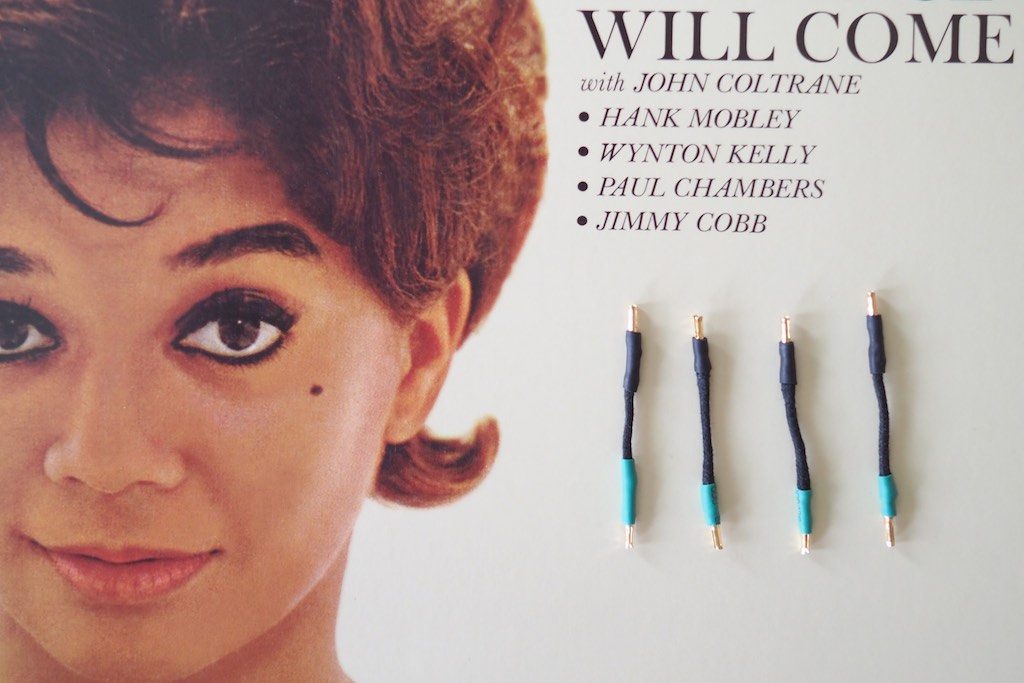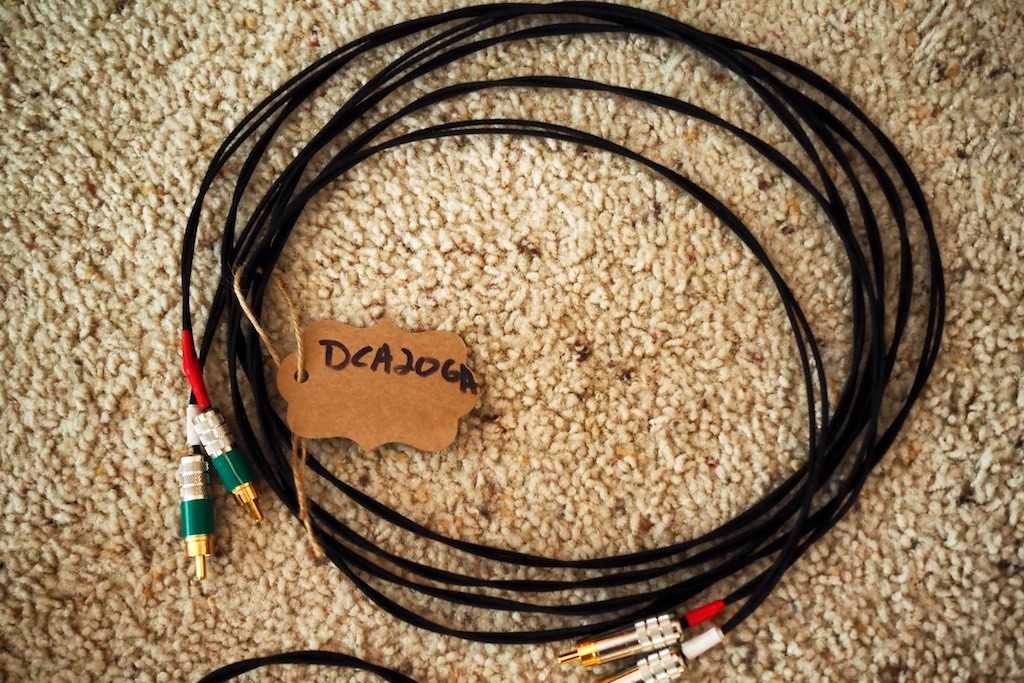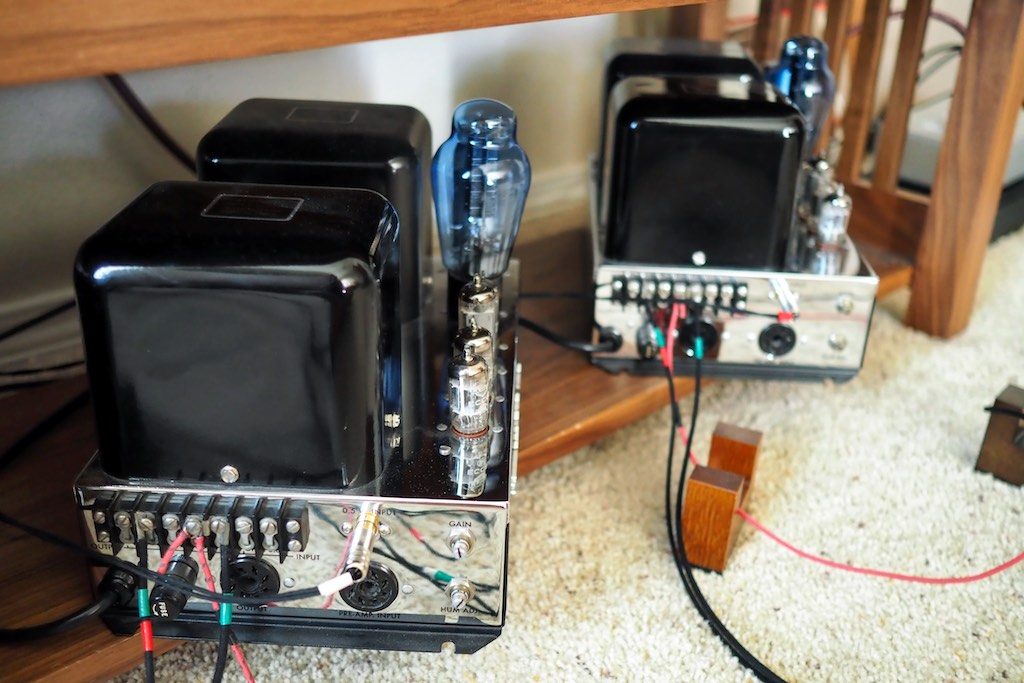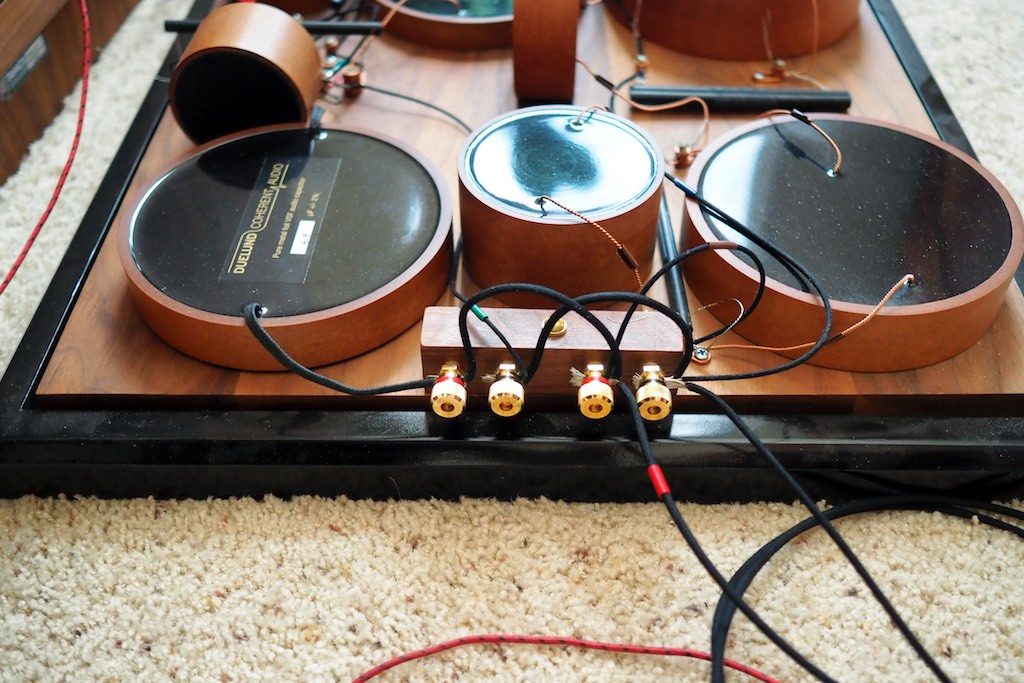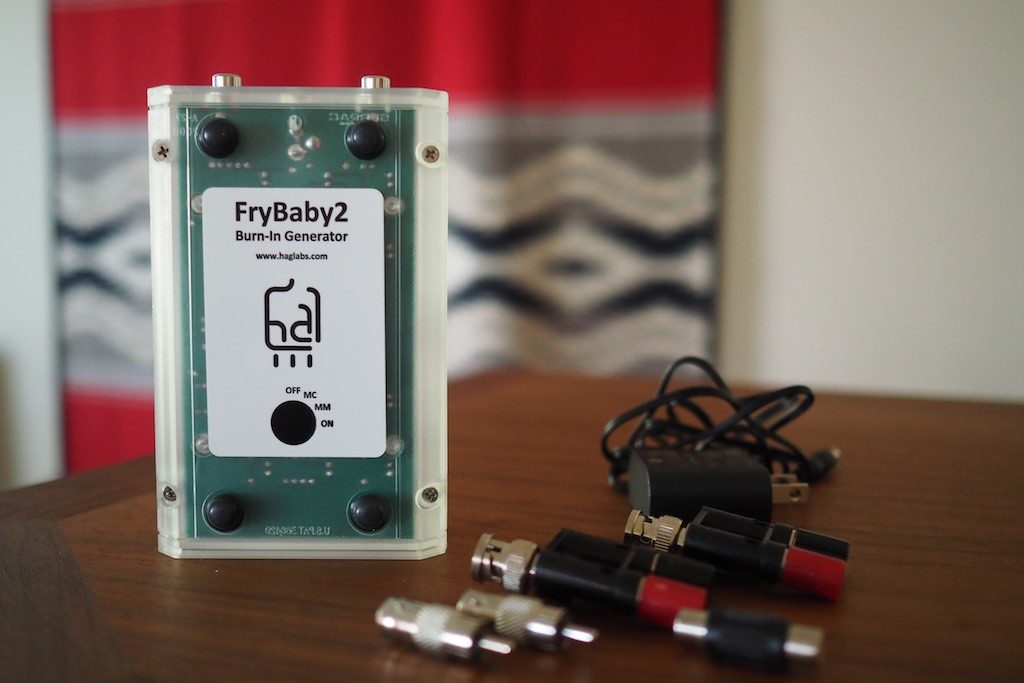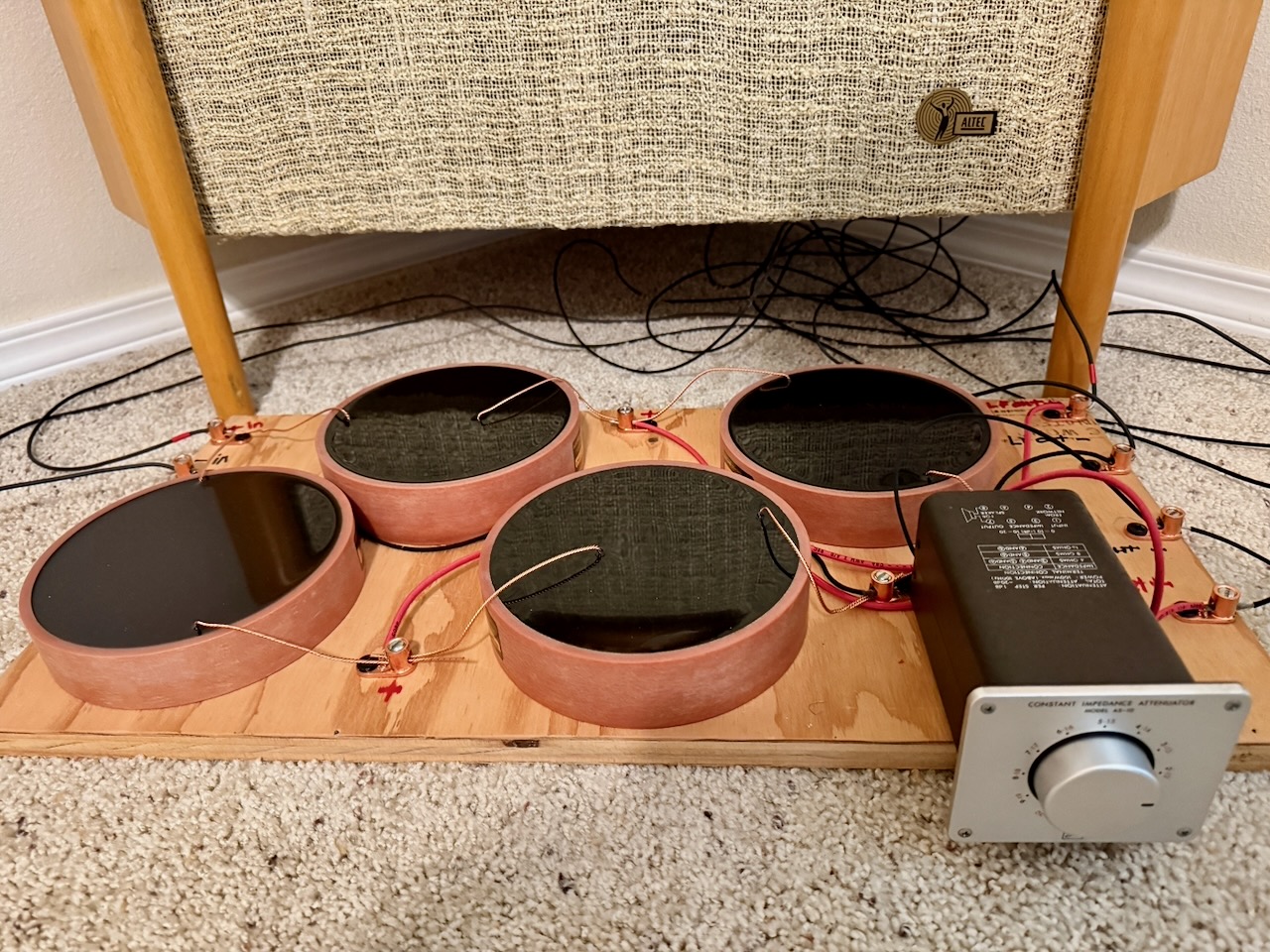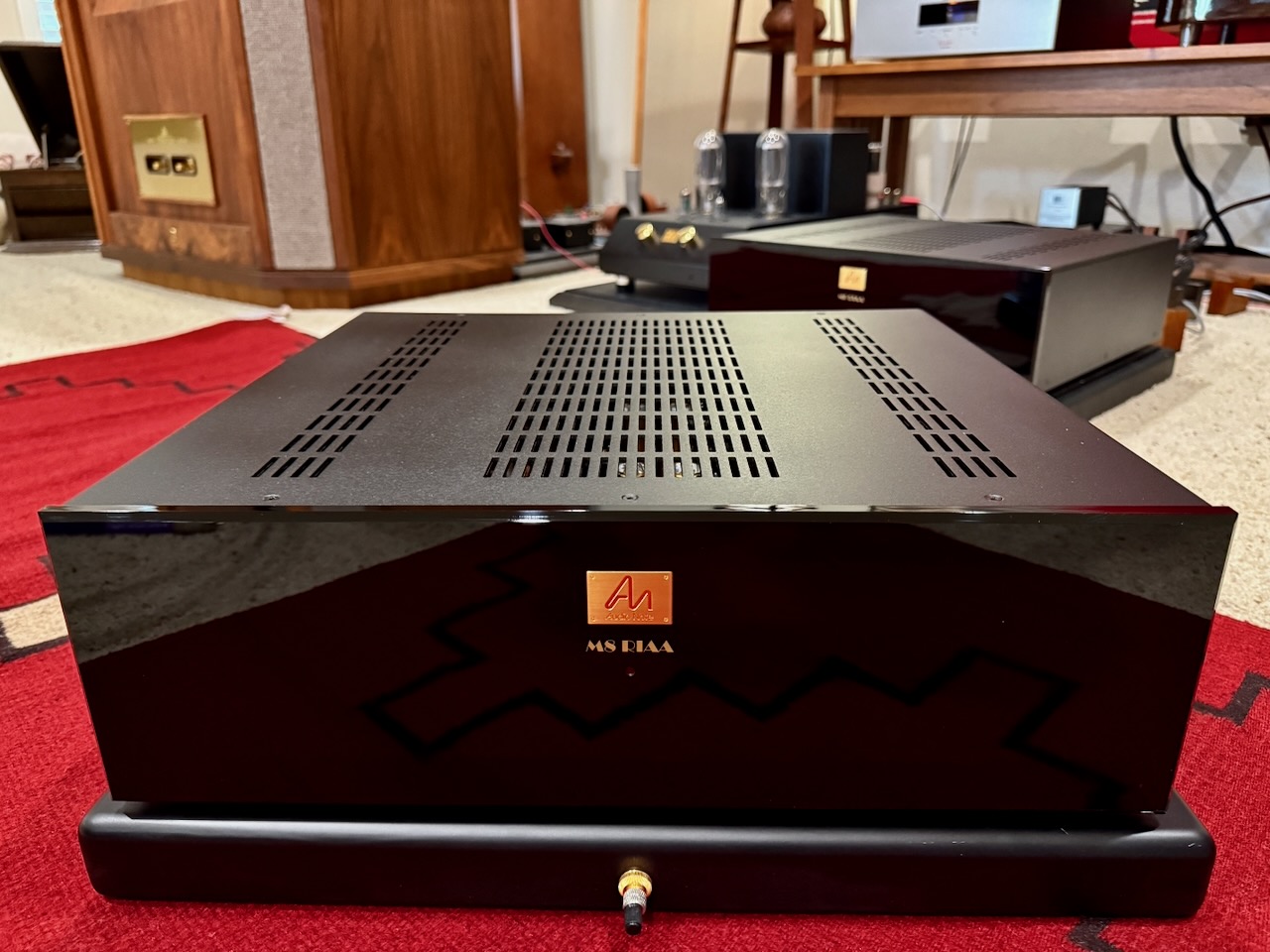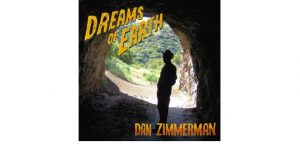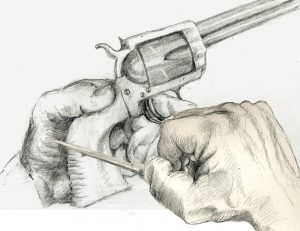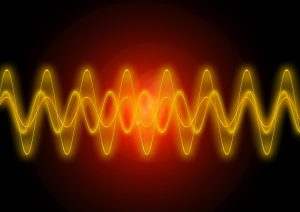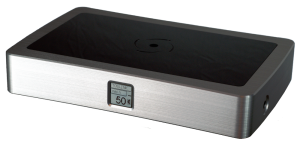Back in Issue 88 of Positive Feedback I wrote about the Duelund Coherent Audio DCA16GA tinned-copper audio cable that I've been using for building interconnects, loudspeaker cables, and for the internal wiring of my Tannoy Westminster Royal SE loudspeakers' Duelund CAST external crossovers.
That was a scant seven months ago, and now due to popular demand from audio enthusiasts around the world the Duelund Coherent Audio DCA line of tinned-copper cables has multiplied to include DCA12GA, DCA16GA, DCA20GA, and DCA26GA!
Before I tell you all the details of the Duelund DCA line of cables and my experiences with them, let me back up a little for those of you who are new to the developing story of the nouveau-vintage tinned-copper cable/wire revolution that has been sweeping the audio world over the last few years, and fill you in on what I think is a rather important history behind tinned-copper cables.
Where did tinned-copper cables come from?
Back in 1950's America tinned-copper cables were routinely used in industrial applications, because electroplating copper conductors with tin prevented corrosion and improved their strippability, which made for an altogether more durable & reliable cable for industrial use.
Corrosion was an issue back in the 1950s because the common insulators of the day released sulfur peroxide as they decayed over time, which would then react with the copper conductors to form copper sulfide, which degraded the cables' performance and durability, and eventually necessitated replacing them.
Image is public domain
However, with tinned-copper wire, the sulfur peroxide released from the insulators couldn't degrade the copper by forming copper sulfide, thus protecting the performance characteristics and the durability of the cables, and giving them a much longer service life.
Another factor was that for the shielded cables of the 1950s, the composition of the shielding made it difficult to strip away from bare copper conductors, so tinned-copper conductors were used, as they were easier to field-strip in preparation for use, making life easier for cable installation into industrial applications or commercial products.
So, the origin of tinned-copper cables was related to the purely practical reasons of preventing corrosion and easing strippability, making the wire more durable, reliable, and easy to handle in industrial and commercial applications.
The Use of Tinned-Copper Conductors in Vintage Electric Guitars and Audio
Of particular interest to musicians and audio enthusiasts will be the use of tinned-copper conductors in vintage electric guitars and their amplifiers, and in vintage audio equipment.
Image is public domain
Certain vintage electric guitar voices are forever etched into our minds from the music of Chuck Berry (Gibson ES 350), Eric Clapton ('Blackie' Stratocaster), Keith Richards ('Micawber' Telecaster), and Neil Young ('Old Black' Gibson Les Paul), for a few examples.
The electric guitar guys like to use the term 'vintage tone' to describe the tonal properties of certain vintage electric guitars and their amplifiers, like the 1957 Gibson ES 350 or Les Paul, the 1954 Fender Stratocaster, the 1950 Fender Telecaster, along with the Fender Deluxe Reverb (think Roy Buchanan) or the Marshall JTM 45 Combo (think Clapton), as a few examples.
Where did the tone go?
As you would expect, electric guitar musicians have noticed the difference in the tonal qualities and musicality of the vintage vs. contemporary electric guitars and their amplifiers, and as far as quite a few electric guitar musicians were concerned, those differences in tone & musicality were not for the better.
Image is public domain
In an effort to duplicate those now rare & expensive vintage electric guitars' tone, the electric guitar guys examined vintage electric guitars and their amplifiers and found that there were certain internal components (as well as the vacuum tube amplification, of course) that contributed to the 'vintage tone' of those great electric guitars and their amplifiers, like tinned-copper wire, or certain vintage capacitors like Black Beauties or Bumblebees, or Allen Bradley carbon composition resistors, for example.
Tinned-copper cables & wires faded from the electric guitar and audio scenes for the same reason they did from industrial applications. It simply costs a lot more money to use them in production products, so in an effort to keep costs down and make more money, tinned-copper got phased out over time as new insulators were developed that didn't corrode bare copper conductors, and new shielding materials were developed that made strippability over bare copper conductors a relative breeze.
Those new approaches for insulators & shielding meant that the tinned-copper conductors that were so much more expensive to manufacture faded from the scene, and the forces at penny-pinching companies buried them in the sands of time, largely erasing them from people's memories, until the electric guitar musicians figured out where the tone had gone.
Back to the tone!
After the electric guitar musician community figured out why the tone & musicality of the vintage gear was superior to the modern gear, a cottage industry arose offering re-wiring kits with tinned-copper pushback wire, exotic vintage capacitors like Black Beauties or Bumblebees, vintage-style pots, vintage-style pickups, and other vintage-style components that helped to restore the lost tone & musicality to contemporary electric guitars and their amplifiers.
This interest in 'vintage tone' was not lost upon the electric guitar industry, which responded by producing special edition guitars that more closely aligned in tone & musicality to their vintage ancestors.
In a Parallel Audio Universe
In a parallel audio universe, Mr. Shirokazu Yazaki, who has enjoyed being an audio hobbyist all his life, and a successful professional audio designer in Japan for over 40 years, Yazaki-san made a discovery in his vintage home audio system that when using vintage Western Electric WE16GA cable as speaker cables, and the old studio standard Belden 8402 microphone cables as interconnects, that his hifi had a much more 'real sound' tonally and musically.
Image is public domain
When I first met Yazaki-san during the review of the SPEC RSA-M3 EX Real Sound Amplifier for Positive Feedback (Issue 78), he shared with me his fondness for the vintage Western Electric WE16GA for speaker cables, and the Belden 8402 microphone cable as interconnects, and kindly sent me a bit of both so I could give them a listen for myself.
I tried the Western Electric WE16GA as speaker cables with my Tannoy Westminster Royal SE loudspeakers, and the Belden 8402 as interconnects with my vintage McIntosh vacuum tube electronics, and I was immediately impressed by their performance, and I bought stocks of both to use in my upcoming audio adventures I had planned.
As I began to write about my experiences with the WE16GA and the Belden 8402 at my blog, Jeff's Place, word quickly got out about their enchanting musical & sonic performance.
Over the course of time, in all four of my home hifi systems, I replaced all of my interconnects with the Belden 8402 microphone cable interconnects, I replaced my speaker cables with vintage WE16GA, and I even completely rewired my Westminster's internally with vintage WE16GA, and did the same for their spectacular Duelund CAST external crossovers.
I was hooked on their unique combination of musical & sonic performance, and Yazaki-san's kindly act towards me turned out to be a "shot heard around the world" in enthusiast audio, and set in motion powerful musical forces by encouraging the use of skinny vintage Western Electric WE16GA cable as speaker cables, and Belden 8402 microphone cable as interconnects.
If you guessed that the Western Electric WE16GA cable and Belden 8402 cable share tinned-copper conductors as a common element, you're exactly right.
These tinned-copper cables quickly became very popular with thousands of audio enthusiasts around the world because of what they did for the music in a home hi-fi system, that is, making it sound much more like 'real' live music in terms of tone, dynamics, presence, timbre, beat, rhythm, tempo, and most importantly, they evoked a strong emotional response to the artists' music.
As a bonus, these tinned-copper cables were also very satisfying in the way they portrayed the non-musical artifacts of the recording process, like imaging, the soundstage, the soundspace, resolution, and transparency, of a recording, which gave the music a reach out and touch it sort of realism that was very vivid, and viscerally enthralling.
In fact, these tinned-copper cables changed the way I thought about the importance of the reproduction of non-musical artifacts from the recording process, and how they could enhance the enjoyment of the recorded music listening experience.
As a bonus, these tinned-copper cables were also inexpensive, and many listeners were able to wire up their entire system with them for a few hundred dollars.
While doing some hot-rod modifications to my vintage McIntosh MC30 monaural vacuum tube amplifiers, I realized that my vintage McIntosh gear was wired internally with tinned-copper wire, and thus found out that just like with those vintage electric guitars and their amplifiers, that vintage audio electronics 'vintage tone' was due in part to being wired with tinned-copper wire.
The exceptional tone and musicality of tinned-copper wire/cables had now been rediscovered in both the world of electric guitars and in enthusiast audio.
People were taking notice of tinned-copper cable/wire, and word was spreading fast.
Some of that notice wasn't so good, as some sellers on eBay started capitalizing on the wave of WE16GA popularity by selling fake WE16GA as the supply of real WE16GA began to go extinct.
I warned my fellow audio enthusiasts about the fake WE16GA situation, and at the same time I was also starting to worry about the dwindling stocks of vintage WE16GA, as my own stash of vintage Western Electric WE16GA was starting to run low, and I still had a lot of ideas for audio adventures that I wanted to try using it for.
Duelund Coherent Audio DCA16GA
Sometimes a bit of serendipity is at play in audio, as it is in life, and it certainly was in this case, as Frederik Carøe at Duelund Coherent Audio in Denmark had been observing the wave of passion that had been generated by the now nearly extinct Western Electric WE16GA.
Frederik came up with the idea that he should build a purist version of the highly desired Western Electric WE16GA cable, with an identical number & gauge of tinned-copper conductors (26 strands of 0.25mm diameter tinned-copper wires).
In the tradition of Steen Duelund's philosophy that natural materials produce more natural tone, Frederik wanted to clothe the DCA16GA's conductors in a baked oil-impregnated cotton dielectric, instead of the vintage Western Electric's dielectric of plastic inner-sleeve and red & black fabric outer covering.
Frederik asked me what I thought of the idea, and of course I was very excited about it, and I thought it would open up a whole new era of audio adventures around the world for audio enthusiasts!
When the Duelund DCA16GA finally arrived on my doorstep, I began to experiment with it in my hifi system, and compare it to the vintage Western Electric WE16GA I had been happily using.
As you know if you read my Positive Feedback article in Issue 88, I was really impressed with the new Duelund DCA16GA, and I thought it bettered the vintage Western Electric in every way.
Not only that, but the Duelund DCA16GA could be bought from HiFi Collective in the UK, and Parts ConneXion in North America, for $9.99 USD/meter ($3.33/foot), which was actually less expensive than what I paid per meter for a spool of Western Electric WE16GA.
That's a bargain price for what is essentially a custom, hand-assembled audio cable, that betters the legendary vintage Western Electric WE16GA in every way, and I applaud Frederik for making the superb Duelund DCA16GA available to audio enthusiasts for such an affordable price.
The fact that you could build a world-class pair of 2-meter speaker cables (bare wire terminations sound best) for well under a $100 USD, was a welcome surprise to audio enthusiasts around the world, and I got daily emails from readers who vastly preferred the inexpensive DCA16GA to their ultra-expensive cables, then sold their expensive speaker cables, and never looked back.
The fact that one could easily build an inexpensive set of world-class interconnects with the Duelund DCA16GA also blew audio enthusiasts away, as a one-meter pair of DCA16GA interconnects terminated with the venerable Switchcraft 3502AAU RCA ($3.94 each at Mouser) could be built for less than $60 USD (above).
When audio enthusiasts began selling their 'high-end' speaker cables and interconnects that sold for many thousands of dollars, in favor of Duelund DCA16GA speaker cables and interconnects that sold for less than a $100 USD each, word quickly began to spread.
As you might surmise, the Duelund DCA16GA cable has become very popular with audio enthusiasts, with the first production run selling out only six days after it was released. The second production run sold out similarly quickly, but now after getting a few more production runs under their Duelund belt, I understand that availability of DCA16GA has stabilized, and Frederik is able to keep up with the demand without the long waits that were common earlier.
Tinned-copper is about the tone!
The most frequent question I get asked about tinned-copper audio cables is what they sound like compared to regular copper or silver cables.
If you ask a violinist why a Stradivarius violin sounds better than most other violins, they'll say simply, "They have better tone."
If you ask one of the electric guitar guys what tinned-copper cable sounds like in their guitars compared to copper or silver cables, they'll say simply, "Tinned-copper cables have better tone."
When a musician says one instrument has better 'tone' than another instrument, what they're really saying is that the instrument is capable of greater musical expression when played by a talented musician.
So, when the electric guitar guys say their guitar has better tone when wired with tinned-copper, they are saying that it is capable of greater musical expression when they play it.
What do tinned-copper cables sound like in audio applications?
In audio, when I say that I think tinned-copper cables have better 'tone' in my system than copper or silver cables, I am saying that when I'm playing music over my hifi system it sounds more expressive and 'real' when I have it wired up with tinned-copper cables.
Just saying that tinned-copper cables 'have better tone' and provide for a more expressive and 'real' sound doesn't really tell the whole story for audio.
When musicians talk about 'tone' in terms of an instrument they're usually referring to its general character or quality of the sound, and the way it complements and elevates a musician's playing, so 'tone' tends to be a bit of a catch-all term describing the musicality of an instrument in response to a talented musician playing it, but in audio it is a little bit different.
In general audio terms, I might say the 'tone' voicing of my system sounds more information rich, natural, and colorful, with tinned-copper cables.
In more specific audio 'tone' terms, I would say that with tinned-copper cables the timbre of instruments sounds much more accurate and 'real' to me, with lots of meaningful natural nuance resolved.
Tinned-copper cables also offer a rather remarkable resolution of tone color (those chordal variations resulting from adding additional pitches to three tone triads that give different styles of music their 'sound' and emotional feel), which I think jazz enthusiasts (like myself) should take particular note of, as jazz employs the extensive use of complex and exotic tone colors.
Wait until you hear how utterly real and magical trumpets, upright bass, guitars, and percussion, sound and feel when listening to jazz, I was totally mesmerized with what I was hearing from the tinned-copper cables.
Tinned-copper cables are transparent and resolving, much like silver cables, but with more natural timbral textures, a greater sense of the recorded space, and there is an information rich nuance to the presentation of the music both harmonically and dynamically that sounds very realistic and satisfying.
This tinned-copper transparency & natural sounding resolution works wonders with harmonies too, and I'm constantly surprised by the important harmonies emerging from the music that went largely unnoticed with other even extremely well-regarded copper or silver cables.
My experience has been that tinned-copper cables more closely approach the sound, feel, and emotional impact of live music, in terms of timbre, melody, harmony, rhythm, dynamics, tempo, tone color, beat, and the ability to play naturally at live-like volume levels, than do other copper or silver cables in my experience, which has made tinned-copper cables tremendously more exciting, emotionally engaging, and ultimately more satisfying to listen to music with, than the other cables I have used.
Which tinned-copper cable is best for audio?
The second most frequent question I get asked is, "Which tinned-copper cable sounds best?"
That's a little like asking, "Which guitar string sounds best?"
Well, in the case of a guitar what string sounds best depends on which string position you're talking about. Are you referring to the 6th, 5th, 4th, 3rd, 2nd, or 1st string?
The different positions utilize different gauges of wires, and the best string for each position is a different gauge of wire.
Take the Martin medium SP's that I prefer on my Gibson Advanced Jumbo and my Collings OM cutaway guitars, which have a gauge range of 13-17-26-35-45-56 for the 6th through 1st strings.
It might not be intuitive at first, but the guitar gauge range analogy also applies to audio, as the best sounding tinned-copper cable for your use will depend on what position you are putting it in your hifi, and on your personal tastes for dialing in a particular voicing for your system.
Sonic and Musical Trends Vary According to Tinned-Copper Cable/Wire Gauge Size
There's another guitar-audio analogy that I've found to hold true through my experiences with the Duelund DCA lineup of tinned-copper cables, which is that overall tone, and more specifically, individual musical and sonic qualities, depend on the gauge size of the cable.
With the guitar in standard tuning, as you ascend through the 6th to the 1st string with the Martin medium SP strings I prefer, the relationship of pitch, frequency, and gauge goes from lowest to highest in the order of E (82.41 Hz, 13 GA), A (110.00 Hz, 17 GA), D (146.83 Hz, 26 GA), G (196.00 Hz, 35 GA), B (246.94 Hz, 45 GA), and E (329.63 Hz, 56 GA). The 1st string E is an octave above the 6th string E.
The sound that you hear as you go from the 6th string to the 1st string ascends in frequency as the gauge gets larger. The 13 GA gauge 6th string E produces a lower note, with a warmer and richer character, and the 56 GA 1st string E produces a higher note, with a brighter and clearer character.
Overall, as you move from the lower gauge strings to the higher gauge strings on the guitar, the sound progressively goes from lower, warmer, and richer notes, to higher, brighter, and clearer notes.
While the principles involved are decidedly different between guitar strings and cables in audio systems, the gauge trend with the Duelund DCA tinned-copper lineup of wire does follow the same sort of trend you hear with guitar string gauges.
The smaller-gauge tinned-copper cables (like the DCA12GA) go from sounding warmer and richer, to sounding brighter and clearer with the larger-gauge tinned-copper cables (like the DCA26GA).
So, I've found the Duelund tinned-copper DCA cables to progressively go from warmer and richer to a brighter and clearer presentation as the gauge size increases (there's an inverse relationship between gauge size and wire diameter, so as gauge size increases wire diameter decreases).
I have also observed with the Duelund DCA tinned-copper cables/wire, that as you go from a smaller to a larger voltage and current amplitude of a time-varying audio signal, the choice of the preferred gauge size trends according to the voltage and current amplitude.
For sources like phono cartridges, which put out a comparatively small signal amplitude, I've found they tend to sound better musically and sonically with larger gauge-size wire (the larger the gauge-size the smaller the diameter of the wire), like the Duelund DCA26GA (above), for example.
As one moves up the chain of amplification with larger amplitude signals, the best match tends to become increasingly smaller gauge-size cables.
So, generally speaking, my experience has been that smaller signals tend to be complemented musically and sonically better by smaller wires, and larger signals tend to be complemented musically and sonically by larger wires.
For example, smaller diameter wires like the Duelund DCA26GA make for fantastic sounding headshell leads, but for interconnects between my step-up transformers (SUTs) and my preamplifier, or my preamplifier and power amplifiers, the mid-sized diameter cables like the Duelund DCA16GA or DCA20GA makes for a very nice choice. From my power amplifiers to my loudspeaker crossovers the larger diameter Duelund DCA12GA cable made for a superb choice. In the above photo, you can see the DCA16GA, DCA20GA, and DCA26GA left to right.
An Overview of the Duelund Coherent Audio DCA Lineup of Tinned-Copper Cables
I am looking forward to telling you all about my adventures with the full lineup of the new Duelund Coherent Audio DCA tinned-copper cables, which have been transformative for my various hifi systems' performance.
I am really very happy that the Duelund DCA16GA wire has been such a big hit for Frederik, as its popularity has encouraged Frederik to offer Duelund DCA tinned-copper cables/wire in various gauges.
Having these various gauges of DCA tinned-copper cables/wire available has turned out to be a tremendous benefit for getting my system voicing dialed in musically & sonically to achieve exactly the kind performance I'm wanting at the time for a particular combination of equipment, as I'll tell you more about in a moment.
A bit about the Duelund DCA cable/wire nomenclature: The number in middle of the Duelund DCA tinned-copper cables' names identifies the wire gauge, so "DCA16GA" stands for Duelund Coherent Audio 16-gauge tinned-copper cable, DCA12GA is 12-gauge, and so forth.
Wire gauge size follows the convention that the bigger the gauge size number, the smaller the diameter of the wire. So, the DCA12GA cable is a sizable cable, and correspondingly the Duelund DCA26GA is a very fine wire. So, the order of increasing size is DCA26GA < DCA20GA < DCA16GA < DCA12GA.
By convention a cable is defined as having two or more conductors, while a wire is defined as having a single conductor, although the terms are often used interchangeably, as you'll catch me doing occasionally.
All of the Duelund DCA lineup of cables use the same oil-soaked and baked cotton dielectric, as you can see in the photo of the DCA16GA above, varying only in their diameter to fit the various wire gauges they encase.
Frederik says the oil impregnated cotton dielectric is baked "so people won't get a messy cable" and that "its main role is to make the dielectric anti-static, and the cotton more durable."
All of the Duelund DCA gauges of tinned-copper cables share a unique combination of intensity of tone color, dynamic prowess, timbral realism, vivid presence, and a compelling portrayal of beat and tempos, that distinguishes them from copper or silver cables, and makes them immensely satisfying for me to listen to music with.
DCA26GA: The Duelund DCA26GA wire uses 1 strand of 0.40mm diameter tinned-copper wire (far right in the above photo). Price is approximately $5.50 USD per meter.
As you'll read about in a moment, the DCA26GA wire makes for phenomenal headshell leads (photo above).
After hearing what the DCA26GA can do as headshell leads, I'd also like to rewire my Ortofon SPU Classic GM MkII stereo phono cartridge (above) internally with the DCA26GA, I think it would be a phenomenal tonal match for the Classic SPU, but I haven't had time to embark on that little adventure yet.
I suspect the DCA26GA could also make for superb tonearm cables, or even internal tonearm wiring, but I haven't had the chance to try those applications yet either.
You could consider the Duelund DCA26GA to be like the 1st (E) string of the guitar, being clean, clear, pure, dynamic, vivid, and with extremely nuanced sounding timbral, tonal, and dynamic details, making it ideal for smaller signal amplitudes near the phono source, while still maintaining classic tinned-copper characteristics of intensity of tone color, dynamic prowess, timbral realism, vivid presence, and a compelling portrayal of beat and tempos.
DCA20GA: The Duelund DCA20GA cable uses 26 strands of 0.15mm diameter tinned-copper wires (middle wire in the photo below), which you might note is the same count and diameter of conductors contained in the Belden 8402 microphone cable. Price is approximately $6.75 USD per meter.
Continuing my guitar string analogy, the Duelund DCA20GA is like the 3rd (G) string, it's richer and warmer in comparison to the 1st (E) string, but still transparent, pure, and possessing a richness of detail in tone color resolution, timbral textures, and harmonic nuance, while still maintaining classic tinned-copper characteristics of intensity of tone color, dynamic prowess, timbral realism, vivid presence, and a compelling portrayal of beat and tempos.
You could consider the Duelund DCA20GA cable to be a purist ultra-high-performance version of the Belden 8402 microphone cable, able to bring to sources a life-like musicality as interconnects for their mid-level amplitude signals.
The shielded version of the DCA20GA I built (photo above) makes for a phenomenally good tonal match as an interconnect between the Arai Lab MT-1 step-up transformer (for the Sumile moving-coil phonograph cartridge) and my vintage McIntosh MX110Z's phono inputs.
I also built an unshielded 2-meter set of Duelund DCA20GA interconnects (photo above), that have performed extremely well as interconnects between my vintage McIntosh MX110Z tuner-preamplifier's outputs.
I've also found the Duelund DCA20GA cable to be an exceptional match tonal match for the wiring in the high-frequency circuit of my Westminster's external Duelund CAST crossovers (above).
DCA16GA: The Duelund DCA16GA cable uses 26 strands of 0.25mm diameter tinned-copper wires, just like the vintage WE16GA does, but with a musically and sonically better sounding oil-soaked and baked cotton dielectric. Price is approximately $9.99 USD per meter.
This DCA16GA is the original Duelund tinned-copper cable that started it all, and the importance of its contribution to the 'art of tone' cannot be overstated.
In the Duelund DCA line of tinned-copper cables, the DCA16GA is at the apogee of the tinned-copper characteristics of intensity of tone color, dynamic prowess, timbral realism, vivid presence, and a compelling portrayal of beat and tempos.
The DCA16GA has the most tone color intensity, macro dynamic prowess, vibrant timbral textures, and vivid presence, of all the DCA tinned-copper cables.
In my guitar string analogy, the Duelund DCA16GA is like the 5th string (A) string, with more midrange and bass punch, vivid tone color intensity, and organic timbral texture, than 3rd (G) string-like DCA20GA, with its smoother, richer, and more detailed presentation.
I have found the DCA16GA to work well as speaker cables (above), as internal wiring for the low-frequency sections of my Duelund CAST crossovers (also above), and as shielded or unshielded interconnects (below).
The Duelund DCA16GA is a very flexible cable from an application standpoint, and works well in a wide variety of applications, giving a live-like Kodachrome color intensity to the music listening experience.
DCA12GA: The Duelund DCA12GA cable uses 65 strands of 0.25mm diameter tinned-copper wires, and as you can see in the Duelund DCA 'family photo' below, it is a massive cable that is well suited for use as speaker cables. Price is approximately $16.99 USD per meter.
The Duelund DCA12GA is the 6th string E in my guitar string analogy, having a big, rich, smooth, and nuanced presentation, but it tones down the vivid Kodachrome-like tone color intensity, explicit timbral textures, and vivid presence of the DCA16GA, just a bit, to make for a very nicely balanced speaker cable.
In the photo above, from top to bottom, you can see the DCA12GA, DCA16GA, DCA20GA, and DCA26GA in the Duelund DCA family portrait.
The Duelund DCA tinned-copper cable/wire is available in the UK from HiFi Collective, and in North America from Parts ConneXion.
The Art of Tone
I refer to the process of voicing an audio system so that the overall performance matches an individual's personal needs and wants, both musically and sonically, as "the art of tone".
The Duelund DCA line of tinned-copper cables/wire makes for an impressingly powerful medium for achieving the "art of tone" in one's audio system in exactly the way you want it to be, both musically and sonically, and there is definitely an art to selecting a complementary DCA gauge match for the particular positions in an audio system to voice the overall 'tone'.
I'd like to share some specific examples with you as I progress from source to loudspeakers in my Tannoy Westminster Royal SE loudspeakers and vintage McIntosh electronics based audio system that I think will provide some examples and guidance for you to begin an audio "art of tone" adventure of your own.
There is definitely an art to choosing which gauge of Duelund DCA tinned-copper cable/wire will best complement each position in an audio system, and I am going to share with you what I've found out along the way with my Tannoy Westminster Royal SE loudspeakers and vintage McIntosh electronics based audio system.
Let's start our 'art of tone' adventure with my vinyl source, a hot-rodded Garrard 301 (Classic Audio 301) in a beautiful plinth made by Christopher Thornton at Artisan Fidelity, mounted with a Pete Riggle Audio Engineering Woody SPU tonearm, and a Thomas Schick tonearm. You can read more about it HERE and HERE.
I might add that I have a fondness for SPU phonograph cartridges, so 12-inch tonearms with an SME/SPU G mount that allows me to use various SPU phonograph cartridges and/or headshells, I consider a must-have feature.
An Art of Tone Adventure with Duelund DCA26GA Tinned-Copper Headshell Leads
I had an illuminating moment when I tried some headshell leads made from vintage Western Electric WE24GA wire that Yazaki-san sent me to try on my Yamamoto headshell. The transformation was dramatic, the music took on a warm, rich, colorful presentation that was a leaps and bounds improvement over the stock headshell wires.
I have learned that the stock leads that come with headshells leave a lot to be desired, and generally don't sound very good either musically or sonically. Most of them are pretty much the equivalent of the free RCA interconnects you get with mass market electronics that you toss in the trash after you open the box.
It turns out that replacing stock headshell leads with good tinned-copper headshell leads makes as much or more of a performance improvement than you get when replacing average interconnects or speaker cables with good ones—the difference is not subtle!
I've tried 22GA (Gavitt), 24GA (Western Electric), and 26GA (Duelund) tinned-copper headshell leads and found them to follow the trends I discussed earlier for gauge-size, where the greater the diameter of the wire, the warmer and richer the overall presentation was.
So, of the headshell leads I've used with my Schick headshell, the 22GA (Gavitt) was the warmest, the 24GA (Western Electric) was the next warmest, and 26GA (Duelund, photo above) was the least warm. I might add that all three of these tinned-copper headshell leads were hugely better than the stock Schick (or Yamamoto) headshell leads.
Another trend I observed was that as the diameter of the headshell leads decreased, the amount of resolution increased, the sense of recorded space became more obvious, the tone became brighter and more forward, the soundstage depth was enhanced, imaging became more vivid, the distinctness of tempos and beat became more apparent, there was more dynamic nuance apparent from soft to loud, and the amount of nuance in timbral textures and subtle tonal details increased.
With the Sumile phono cartridge mounted in the Schick headshell (photo above), the DCA26GA headshell leads provided an astonishing amount of recorded space, soundstage layering that disappeared into its depths, vivid imaging, realistic portrayals of tempos and beat, and timbral textures and tonal details that were extremely rich in nuance.
The downside of the DCA26GA headshell leads with the Sumile mounted on the Schick headshell was that the presentation was brighter and more forward than I like, and while it made 'sonic spectacular' recordings sound, well spectacular, less well recorded music suffered in musicality.
So, for the review of the Sumile phono cartridge in Issue 92, I ended up going with the DIY Gavitt 22GA tinned-copper pushback wire headshell leads I made (photo above), as their tonal balance flattered a wider range of recording quality, albeit at a significant loss of the sonic benefits I mentioned above for the DCA26GA headshell leads.
Then I learned a secret about how to keep all the good sonic qualities of the Duelund DCA26GA headshell leads, while increasing their warmth and richness so that they were no longer bright or forward.
The secret? Voltage-only conditioning of the DCA26GA headshell leads, which warms them up and smooths them out, while maintaining all their desirable sonic qualities.
When writing about audio, I don't have the luxury of the amount of time it takes run-in cables, which can be a 100+ hours, so I use combined voltage and current conditioning to speed the run-in process of dielectric and conductors, respectively.
However, the Duelund DCA tinned-copper cables haven't responded as predictably to combined voltage/current conditioning as previous cables in my experience had, and tended to become leaner and less musical with conditioning, which was definitely not the desired outcome.
I had resigned myself to letting the Duelund DCA cables run-in naturally, until Bill told me about his results using voltage-only conditioning with his Hagerman Audio Labs cable conditioner (thank you, Bill!), that allows the user to separate voltage and current conditioning, in order to optimize the results of each kind of conditioning individually.
After Bill's recommendation, I immediately ordered a FryBaby2 from Hagerman Audio Labs ($229 USD) to try for myself with the Duelund DCA tinned-copper cables, and I have been using it for voltage-only conditioning on a variety of Duelund DCA cables since it arrived, each time with superb results.
It turns out that voltage-only conditioning works like magic on the Duelund DCA tinned-copper cables, making them sound richer, warmer, more textured, more naturally nuanced, and altogether more musical, while at the same time maintaining or enhancing their superb sonic qualities.
The significant bonus is that it takes a relatively short time to do voltage-only conditioning of the Duelund DCA tinned-copper cables, say 12 to 24 hours.
From these three different tinned-copper headshell leads I learned an illuminating lesson, that just like with guitar strings, the tone was progressively richer and warmer for the larger diameter wires, but as headshell leads the larger diameter wires sacrificed too much of the nuanced tones, textures, dynamics, and other good traits, of the smaller diameter Duelund DCA26GA headshell leads.
With the FryBaby2 I was able to dial in the amount of richness and warmth I wanted for the DCA26GA (and other Duelund DCA cables) through voltage-only conditioning, while still maintaining or enhancing all their superb sonic traits, resulting in my vision for the best of both worlds musically and sonically.
I found out in my trials with the DCA that conditioning is reversible, so if the cables lean out too much with combined voltage/current conditioning, you can restore as much warmth as desired with voltage-only conditioning.
Conversely, if cables warm up too much with voltage-only conditioning, they can be leaned back out with some combined current/voltage conditioning (or maybe current-only conditioning, which I haven't tried yet), which is a tremendously powerful technique for adventures in the art of tone!
A note on constructing DIY headshell leads: Headshell leads are really easy to construct as a DIY project, and I've been using the Cardas cartridge clips to terminate them, with a bit of heat shrink tubing to stabilize the terminations and keep them from shorting when mounted to the headshell and cartridge pins.
Stock headshell leads are very thin and flexible, so when you connect them to the cartridge or headshell pins they just flex out of the way making for easy connection duties. The larger diameter tinned-copper headshell leads are another story, as they're not nearly so thin and flexible. If you try to install them the same way you do stock headshell leads, there's a good chance you'll break them (don't ask).
The way to avoid breaking them is to form a loop in their middle by bending them in the middle around pencil or another piece of wire, as in the photo above. The loop acts as suspension that allows you to easily install them on the headshell and cartridge pins without breaking them.
If you look closely at the photos above for the Duelund DCA16GA and Gavitt 22GA headshell leads you can see the loops I put into them. It works.
Also, I have some vintage tinned-copper cartridge clips, and some Audiosilente CNC'd and gold-plated cartridge clips that were recommended to me, that are on the way, which I'll try in some future headshell lead 'art of tone' adventures.
For heat-shrink tubing I bought a box of "560PCS Heat Shrink Tubing 2:1, Eventronic Electrical Wire Cable Wrap Assortment Electric Insulation Tube Kit With Box (5 colors/12 sizes)" from Amazon. There's a heat shrink tubing size that will match just about any DIY tinned-copper wire adventure you could think of to try, and the box with 560 pieces costs only $7.99 USD.
An Art of Tone Adventure with Duelund DCA16GA and DCA20GA Tinned-Copper Interconnects
I've been using the exotic Arai Lab MT-1 step-up transformer (in for review) with the Sumile phono cartridge, so next let's explore to the Duelund DCA interconnects I chose to voice and connect the Arai Lab MT-1 SUT to my vintage McIntosh MX110Z's MM phono inputs.
I should take a moment to reiterate that all of the Duelund DCA line of tinned-copper cables share a unique combination of intensity of tone color, dynamic prowess, timbral realism, vivid presence, and a compelling portrayal of beat and tempos, that distinguishes them from copper or silver cables, and makes them immensely satisfying for me to listen to music with.
The different Duelund DCA gauge sizes present those musical and qualities over a spectrum of intensity that makes them well suited for different positions in the music signal amplification chain.
Now that the small amplitude signal from the Sumile moving-coil phono cartridge has been stepped-up in amplitude through the Arai Lab MT-1 SUT, a larger diameter Duelund DCA cable is in order to provide the best tonal match for this next stage in amplification of the signal.
For the SUT to MX110Z connection, I need to use shielded interconnects or I'll get hum from the system, so I added in shielding to the Duelund DCA16GA and DCA20GA interconnects I built.
I like to ground the shielding only on the source end, which I think gives the best combination of sonic and musical performance in a shielded interconnect.
You can see detailed instructions on how to build shielded DCA20GA interconnects at my blog HERE, and you can use the same method to build shielded DCA16GA interconnects.
After numerous listening tests, I found the shielded Duelund DCA20GA interconnects to be my favorite tonal match for the Arai Lab MT-1 to MX110Z phono input connections, and then I further optimized them with 24 hours of voltage-only run-in, which really complemented their overall tonal and sonic qualities.
The shielded and well run-in Duelund DCA20GA interconnects are amazing in this position, with their voicing supporting the Sumile phono cartridge and Arai Lab MT-1 SUT in a tour de force presentation of that important triad of tone, dynamics, and presence, that makes recorded music feel 'real' and 'live' in one's listening room.
Take as an example, the musically superb and very well recorded Egberto Gismonti Sol Do Meio Dia album, where the combination of the Duelund DCA26GA headshell leads with the shielded Duelund DCA20GA interconnects, allows the Sumile phono cartridge to display an astonishing amount subtle tonal, timbral, and dynamic nuance from the fascinating combinations of 8-string guitar, 12-string guitar, kalimba, piano, wood flutes, voice, bottles, percussion, berimbau, tama, tabla, and soprano saxophone, and all of that subtle nuance makes listening to Sol Do Meio Dia even more enchanting and satisfying.
The Duelund DCA26GA headshell leads and shielded DCA20GA interconnect combination enhances the Sumile's information rich and vivid presence, great tone color resolution, high degree of transparency, and high degree of dynamic agility that makes beat, tempos, and rhythm to feel very 'live', which I found made listening with the Sumile on Sol Do Meio Dia even more emotionally engaging and exciting than usual.
The Duelund shielded DCA20GA interconnects gave the Sumile an even more impressively transparent yet natural sounding presentation of Sol Do Meio Dia, with a vivid presence of images on the soundstage, a huge sense of spaciousness, and a deeply layered soundstage, that made Sol Do Meio Dia completely very immersive and exciting to listen to.
For the combination of the Ortofon SPU Classic GM MkII stereo phono cartridge mounted on my Pete Riggle Audio Engineering Woody SPU tonearm, being stepped up through Intact Audio Dual Mono SUTs, the shielded Duelund DCA16GA interconnects (above) that Chris at Parts ConneXion made for me, turned out to be the best tonal and sonic match for connection the SUTs to the MX110Z's phono inputs.
Chris terminated the shielded Duelund DCA16GA interconnects with the very high-quality Duelund gold-plated RCA connectors ($55.95 USD/pair), which feature a natural materials handle made out of the same material that is used to encase the Duelund CAST capacitors, and is a very classy touch!
The refined and full-bodied sound of the Ortofon SPU Classic GM MkII stereo phono cartridge on the Woody SPU tonearm was best matched by the intense tone color, dynamic prowess, timbral realism, and vivid presence, of the shielded Duelund DCA16GA interconnects.
When one thinks of the spectrum of Duelund DCA tinned-copper performance, the DCA16GA is at the apogee of intensity of tone color, dynamic prowess, timbral textures, and vivid presence, that one associates with tinned-copper cable performance, offering dramatic, intensely colorful, and emotionally engaging musical performance.
The Cowboy Junkies The Trinity Session album was gorgeous with the combination of the Ortofon SPU Classic GM MkII stereo phono cartridge, Woody SPU tonearm, and shielded Duelund DCA16GA interconnects.
The Trinity Session with the shielded Duelund DCA16GA interconnects really brought out the acoustic of the Trinity Church, sounding beautifully ethereal, spacious, and rich. Timbral textures were vivid, tone color was vibrant, and Margo's voice was vividly present, and rich and full bodied.
My next adventure in the art of tone was to select a set of Duelund DCA interconnects that brought out the best from the connection to the output of my vintage McIntosh MX110Z's outputs and the inputs of my vintage McIntosh MC30 monaural amplifiers.
The first thing I should say about interconnects is that I don't like to use shielding unless I need to, because in my experience adding shielding to an interconnect always degrades the performance compared to an identical 'nude' interconnect without shielding.
Fortunately, for the connection between my vintage McIntosh MX110Z tuner-preamplifier's outputs and the inputs of my vintage McIntosh MC30 monaural amplifiers shielding is not necessary.
I tried building interconnects from the Duelund DCA12GA (above), DCA16GA, and DCA20GA to hear how they'd sound in the position between the MX110Z and the MC30's.
The Duelund DCA12GA is really too big of a wire for the mid-level signal amplitude coming from the MX110Z, and its size makes it challenging to make an interconnect out of, but I thought I'd it a try to hear what happened. The DCA12GA experiment was a bust, and was a tonal & sonic mismatch for the MX110Z to MC30's interconnect position.
The Duelund DCA16GA interconnects I built (above) were actually a very nice interconnect for use between the MX110Z and the MC30's, displaying their trademark Kodachrome-like intensity of tone color, dynamic prowess, realistic timbral textures, and vivid imaging and soundstaging.
Ultimately, I preferred the tonal match of the 2-meter pair of Duelund DCA20GA interconnects (above) I built for the MX110Z to MC30 monaural amplifiers connections.
The DCA20GA interconnects didn't have quite the full measure of intensity and vividness of the Kodachrome-like DCA16GA interconnects, but they were more evenly balanced top-to-bottom, smoother, more resolving of nuance of tone color, dynamics, timbral textures, and just an overall better tonal match for that position in the signal amplification chain.
I did perform 12 hours of voltage-only conditioning on the DCA20GA interconnects, which I thought brought out their good qualities even more, making them richer, more nuanced, smoother, and more musical overall.
An Art of Tone Adventure with Duelund DCA12GA, DCA16GA, and DCA20GA As Speaker Cables
In my final installment for Part 1, I thought I'd discuss how the Duelund DCA12GA, DCA16GA, and DCA20GA fared as speaker cables.
I built three different pairs of speaker cables to try, a pair of single wire DCA16GA speaker cables, a pair of bi-wire speaker cables with DCA20GA for the high-frequency connections, and DCA16GA for the low-frequency connections, and a pair of single-wire DCA12GA speaker cables.
For the DCA16GA and DCA12GA speaker cables, I connected them to the low-frequency binding posts of my Duelund CAST crossovers, then connected a jumper of the same cable to the high-frequency connections of the crossovers.
All of the combinations of Duelund DCA sounded quite good as speaker cables, but my favorites were the Duelund DCA12GA single-wire speaker cables with DCA12GA jumpers (above) for the high-frequency connections on the Duelund CAST crossovers.
Like the 6th string E on the guitar, the Duelund DCA12GA has a rich, relaxed, overall tonal balance, as well as being evenly balanced from the low to high-frequencies, but with a touch less of the intensity, vibrancy, and directness of the DCA16GA.
Just like the six strings on the guitar that work together to make beautiful music, the Duelund DCA12GA as speaker cables worked together with the Duelund DCA26GA headshell leads and the Duelund DCA16GA and DCA20GA shielded and unshielded interconnects, to produce an astonishingly live-like presentation of the music that was full life, color, dynamic contrasts, timbral and tonal nuance, that made the music absolutely mesmerizing to listen to.
In the photo above you can see the DCA12GA cables as they stretch across the floor through the cables risers.
Summary and Conclusions
All of the Duelund DCA gauges of tinned-copper cables share a unique combination of intensity of tone color, dynamic prowess, timbral realism, vivid presence, and a compelling portrayal of beat and tempos, that distinguishes them from copper or silver cables, and makes them immensely satisfying to listen to music with.
The Duelund DCA line of tinned-copper cables/wire makes for an impressingly powerful medium for achieving the "art of tone" in one's audio system in exactly the way you want it to be, both musically and sonically, and there is definitely an art to selecting a complementary DCA gauge match for the particular positions in an audio system to voice the overall system 'tone'.
I hope with this article I've given you some ideas that will empower you to pursue your own 'art of tone' hifi adventure with the Duelund DCA tinned-copper cables (family portrait below).
I have found it to be immensely satisfying and gratifying to be able to go through each wire position in my system, from source to loudspeakers, and select my favorite Duelund DCA cable/wire whose tonal properties best complement that position in terms of overall musicality and sonics.
I have a few basic guidelines that you can use to start you out in your 'art of tone' adventure.
The first guideline I can offer is to match the amplitude of the signal to the size of the wire.
For very small signal amplitudes user smaller wire, like the Duelund DCA26GA I used for headshell leads.
As the amplitude of the signal is increased through a step-up transformer or a preamplifier, choose a medium-gauge wire like the Duelund DCA16GA and DCA20GA to try as interconnects. There isn't a right or wrong or best here, it's choosing whichever interconnect best complements your equipment voicing and your personal tastes. The best one, is the best one for you.
If you can avoid using shielding in your interconnects they will sound better, but if you need to use shielding like I do with my various step-up transformers, I recommend you ground the shield only at the source end for the best combination of musicality and sonics.
As the signal amplitude gets large, like from the output from an amplifier, choose larger-sized cables as speaker cables, like the Duelund DCA16GA or DCA12GA.
The second suggestion is that after you've settled in on the DCA gauges you want to use at the various connection points in your system, you can fine tune each DCA cable/wire's individual voicing to best complement your system needs and personal preference by using a FryBaby2 conditioning device ($229 USD).
The FryBaby2 is a very worthwhile investment for fine tuning the Duelund DCA cables voicing, by warming them up with voltage-only conditioning, or leaning them out with current conditioning.
If you'll take a little time in selecting the best matching Duelund DCA tinned-copper cables for your various connection points, fine tune them with a little appropriate conditioning, you'll begin to understand what the guitar and audio guys are talking about with regards to the wonderful tonal characteristics of tinned-copper cables.
I would like to thank Frederik Carøe at Duelund Coherent Audio for providing the Duelund Coherent Audio DCA12GA, DCA16GA, DCA20GA, and DCA26GA, that were used in my pursuits of the art of tone!
Frederik, thank you for resurrecting the magic of tinned-copper in contemporary high-performance audio cables that we can all afford to enjoy, well done!
Yes, Part 1 does hint that there will be more to come in a Part 2 one day, but until then, thanks for stopping by Positive Feedback to read my articles, and may the 'art of tone' be with you!
The Duelund DCA tinned-copper cable/wire is available in the UK from HiFi Collective, in North America from Parts ConneXion, and in other parts of Planet Earth by contacting Frederik Carøe at Duelund directly.
All images by Jeff Day unless otherwise noted




